Grasses were always going to be an important part of the garden. They make the link to the meadows and fray the boundary, so it is hard to tell where garden begins and ends. On our windy hillside, they also help in capturing this element, each one describing it in a slightly different way. The Pennisetum macrourum have been our weather-vanes since they claimed the centre of the garden in August. Moving like seaweed in a rock pool on a gentle day, they have tossed and turned when the wind has been up. The panicum, in contrast, have moved as one so that the whole garden appears to sway or shudder with the weather.
Though the pennisetum took centre stage and needed the space to rise head and shoulders above their companions, they are complemented by a matrix of grasses that run throughout the planting and help pull it together from midsummer onwards. Choosing which grasses would be right for the feeling here was an important exercise and the grass trial in the stock beds helped reveal their differences. At one end of the spectrum, and most ornamental in their feeling, were the miscanthus.
Clumping strongly and registering as definitely as a shrub in terms of volume, I knew I wanted a few for their sultry first flowers and then the silvering, late-season plumage. It soon became clear that they would need to be used judiciously, for their exotic presence was at odds with the link I wanted to make to the landscape here. At the other the end of the spectrum were the deschampsia and the melica, native grasses which we have here in the damp, open glades in the woodland. We have used selections of both and they have helped ground things, to tie down the garden plants which emerge amongst them.
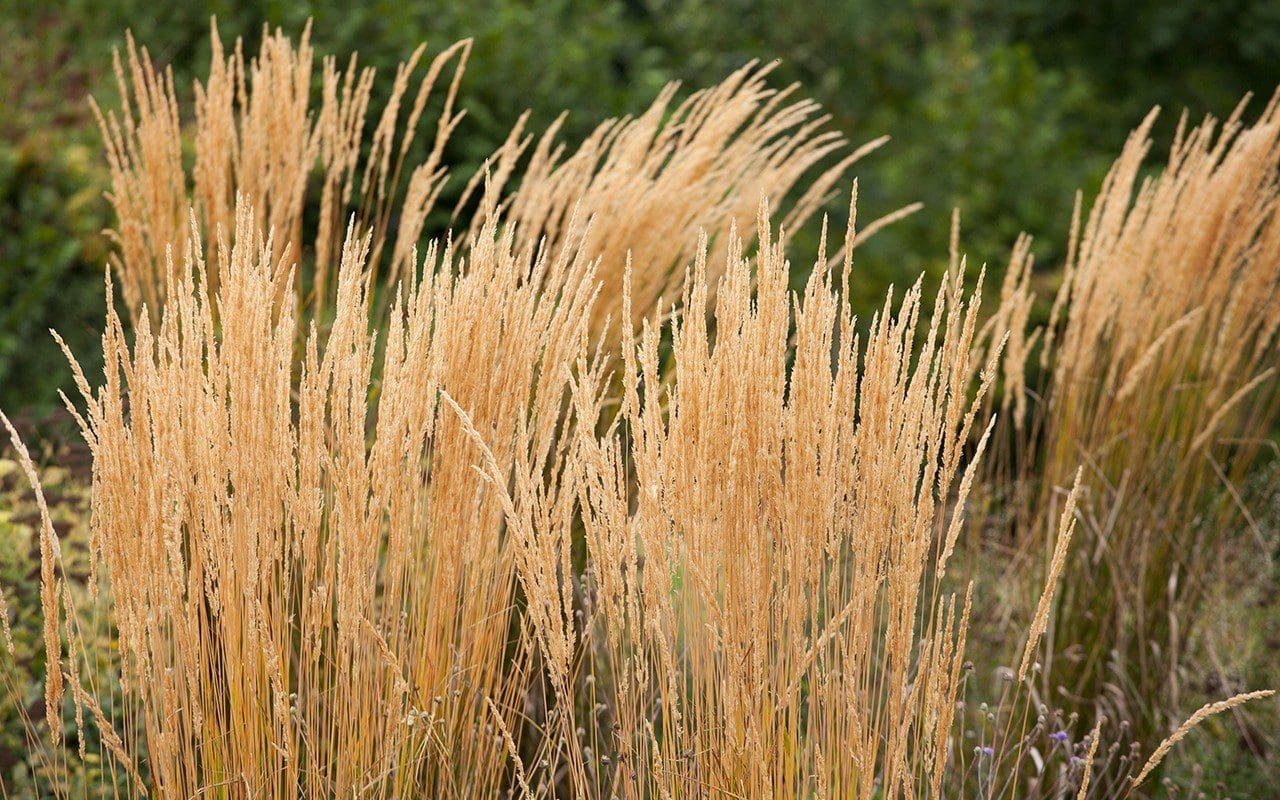 Calamagrostis x acutiflora ‘Karl Foerster’
Calamagrostis x acutiflora ‘Karl Foerster’
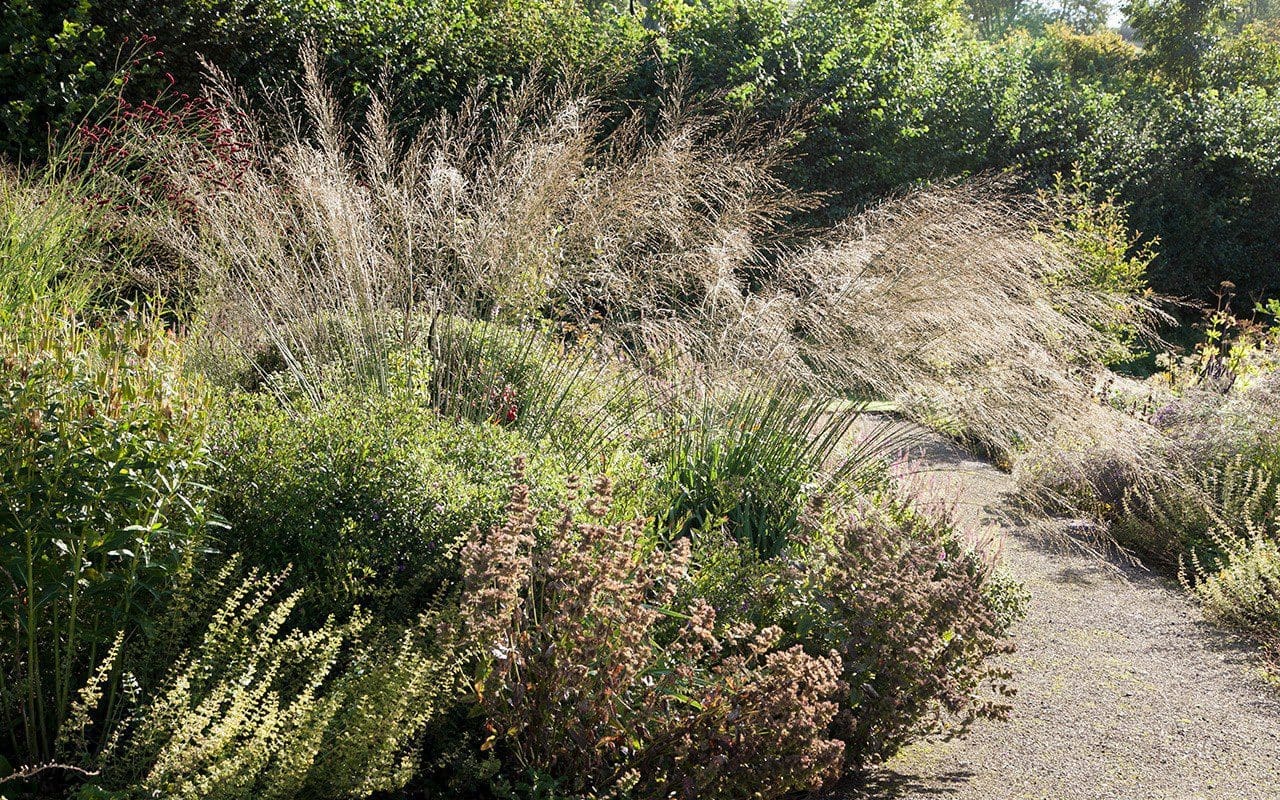 Molinia arundinacea ssp. caerulea ‘Transparent’
Molinia arundinacea ssp. caerulea ‘Transparent’
Falling between to two ends of the shifting scale, we experimented with a range of genus to find the grasses that would provide the gauziness I wanted between the flowering perennials. As it is easy to have too many materials competing when choosing your building blocks for hard landscaping, so it is all too easy to have too many grasses together. Though subtle, each have their own function and I knew I couldn’t allow more than three to register together in any one place. Tall, arching Molinia caerulea ssp. arundinacea ‘Transparent’ that is tall enough to walk through and yet not be overwhelmed by would be the key plant at the intersection of paths. The fierce uprights of Calamagrostis x acutiflora ‘Karl Foerster’, scoring thunderous verticals early in the season and then bleaching to longstanding parchment yellow, would need to be given its own place too in the milking barn yard. I needed something subtler and less defined as their complement in the main garden.
Our free-draining ground and sunny, open position has proved to be perfect for cultivars of Panicum virgatum or the Switch Grass of American grass prairies. We tried several and soon found that, as late season grasses, they need room around their crowns early in the season if they are not to be overwhelmed. Late to come to life, often just showing green when the deschampsia are already flushed and shimmering with new growth, it is easy to overlook their importance from midsummer onwards. I knew from growing them before that they like to be kept lean and are prone to being less self-supporting if grown too ‘soft’ or without enough light, but here they have proven to be perfect. Bolting from reliably clump-forming rosettes, each plant will stay in its place and can be relied upon to ascend into its own space before filling out with a clouding inflorescence.
 Panicum virgatum ‘Cloud Nine’. The original stock plant is in the centre.
Panicum virgatum ‘Cloud Nine’. The original stock plant is in the centre.
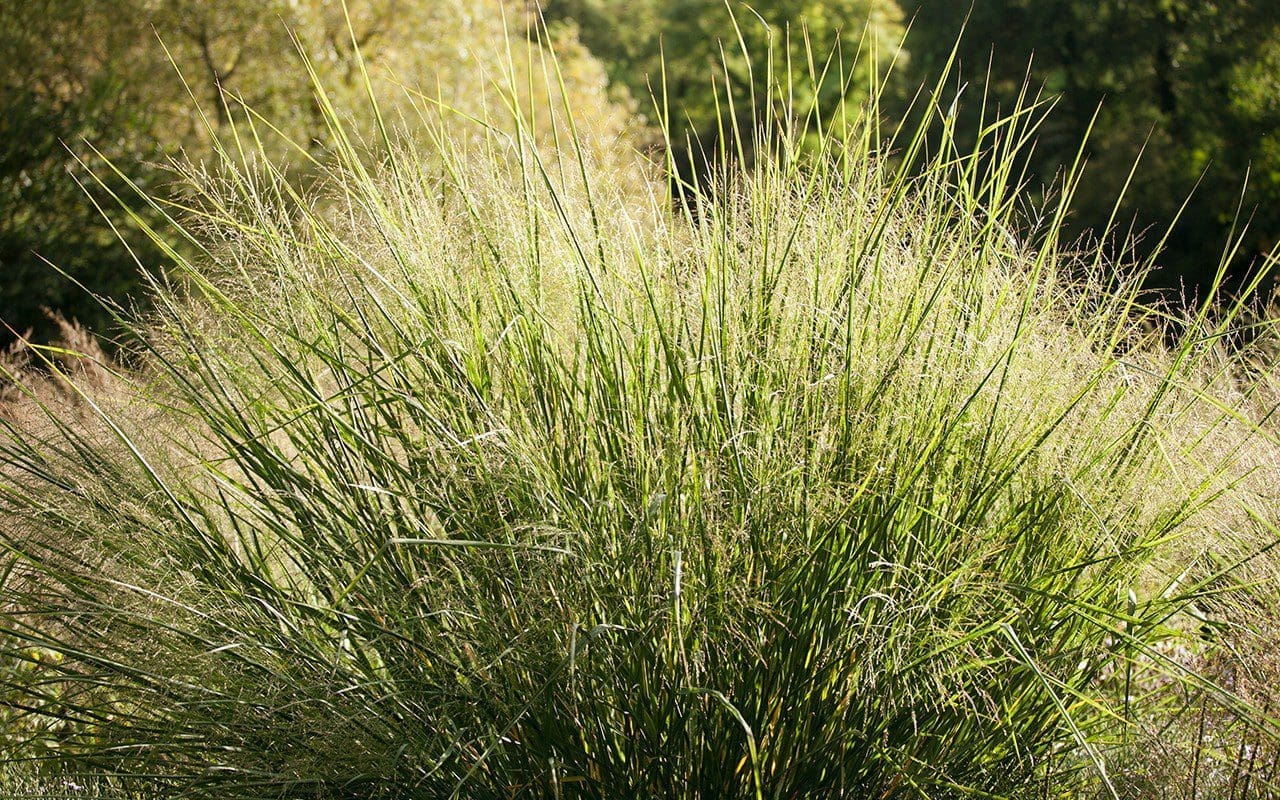 Panicum virgatum ‘Cloud Nine’
Panicum virgatum ‘Cloud Nine’
I tried several and, with the luxury of having the space to do so, some proved better than others. The largest and most dramatic is surely ‘Cloud Nine’. My eldest plant, the original, remains in the position of the old stock bed and the garden and younger companions were planted to ground it. This was, in part, due to it already being in the right place, for I needed a strong presence here where I’d decided not to have shrubs and they have helped with their height to frame the grass path that runs between them and the hedge along the lane. By the time the stock beds were dismantled we were pleased not to have to move it, because the clump is now hefty, and a two man job to lift and move it.
I first saw this selection in Piet Oudolf’s stock beds several years ago, where it stood head and shoulders above his lofty frame. Scaled up in all its parts from most other selections, the silvery-grey leaf blades are wider than most panicum and very definite in their presence. Standing at chest height in August before showing any sign of flower, it is the strongest of the tribe. Now, in early autumn, its pale panicles of flower have filled it out further, broadening the earlier bolt of foliage. If it was a firework in a firework display of panicum, it would surely be the last, the scene-stealer that has you gasping audibly. I like it too for the way it pales as it dies and it stands reliably through winter to arrest low light and make a skeletal garden flare that is paler in dry weather and cinnamon when wet.
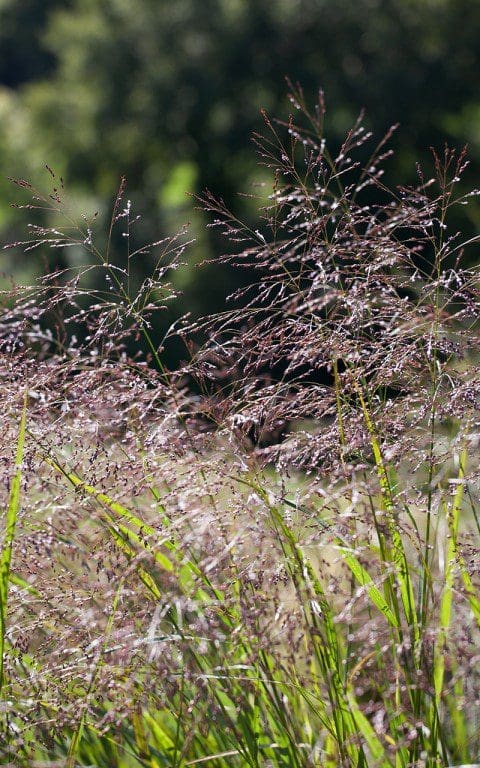 Panicum virgatum ‘Rehbraun’
Panicum virgatum ‘Rehbraun’
I have three other panicum in the garden, which are entirely different in their scale and presence. Though it has proven to be larger than anticipated in our hearty ground and will need moving about in the spring to get the planting just right, I am pleased to have selected ‘Rehbraun’. Calm, green foliage rises to about a metre before starting to colour burgundy in late summer. The base of redness is then eclipsed by a mist of mahogany flower, which when planted in groups, moves as one in the breeze. I have it as a dark backdrop to creamy Ageratina altissima ‘Braunlaub’ (main image) and Sanguisorba ‘Cangshan Cranberry’, which are wonderful as pinpricks of brightness held in its suspension. It is easily 1.2 metres tall here and, weighed down by rain, it can splay, and I have found that several are too close to the path, but I like it and will find them a place deeper within the borders.
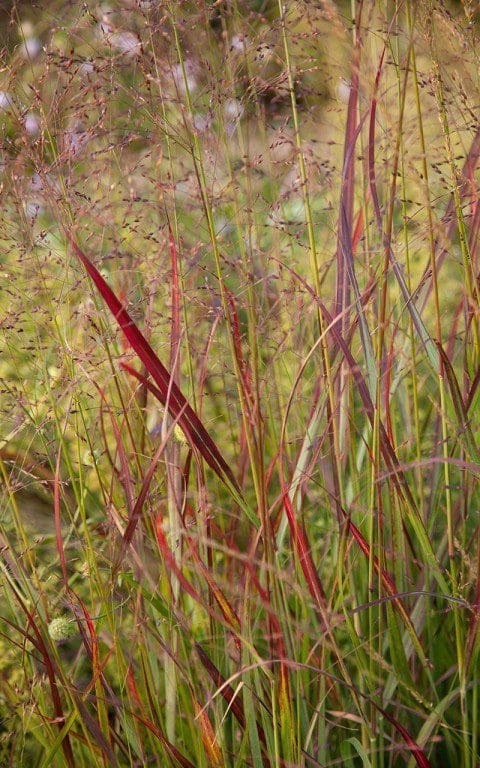 Panicum virgatum ‘Heiliger Hain’
Panicum virgatum ‘Heiliger Hain’
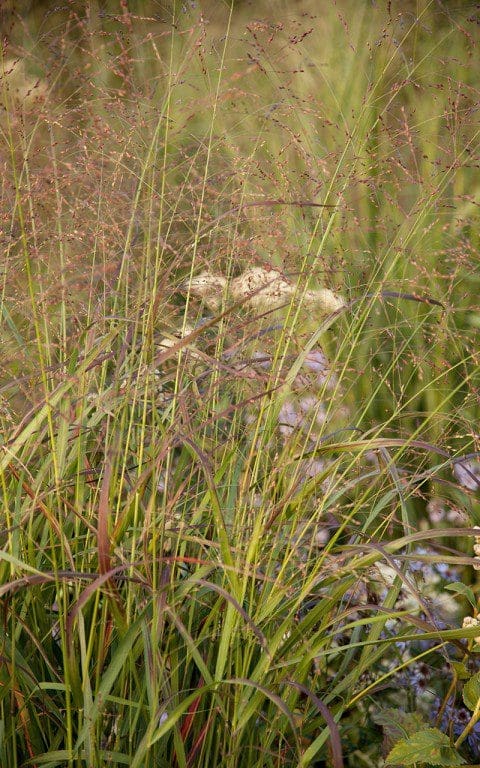 Panicum virgatum ‘Shenandoah’
Panicum virgatum ‘Shenandoah’
Though it has not done as well for me here – it may well be that it is a selection from a drier part of the States – ‘Heiliger Hain’ has been beautiful. Silvery and fine, the leaf tips colour red early in summer and are strongly blood red by this point in the season. It is small, no more than 80cm tall when in flower, and so I have given it room to rise above Calamintha sylvatica ‘Menthe’ and the delicate Succissella inflexa. Similar in character, though better and stronger, is ‘Shenandoah’ which I have drawn through most of the upper part of the garden. Blue-grey in appearance as it rises up in the first half of summer, it begins to colour in late August, bronze-red becoming copper-orange as it moves into autumn. Neil Lucas of Knoll Gardens says it has the best autumn colour of all panicum. It also stands well in winter to cover for neighbours that have less stamina. Where in the right place, with plenty of light and no competition at the base whilst it is awakening, it is proving to be brilliant and will be the segue from the summer garden, slowly making its presence felt above an undercurrent of asters to finally eclipse everything in a last November burn.
Words: Dan Pearson / Photographs: Huw Morgan
Published 29 September 2018
It has been an extraordinary run. Day after day, it seems, of clear sky and sunlight. I have been up early at five, before the sun has broken over the hill, to catch the awakening. Armed with tea, if I have been patient enough to make myself one before venturing out, my walk takes me to the saddle which rolls over into the garden between our little barn and the house. From here, with the house behind me and the garden beyond, I can take it all in before beginning my circuit of inspection. It is impossible to look at everything, as there are daily changes and you need to be here every day to witness them, but I like to try to complete one lap before the light fingers its way over the hedge. Silently, one shaft at a time, catching the tallest plants first, illuminating clouds of thalictrum and making spears of digitalis surrounded in deep shadow. It is spellbinding. You have to stop for a moment before the light floods in completely as, when you do, you are absolutely there, held in these precious few minutes of perfection.
Now that the planting is ‘finished’, the experience of being in the garden is altogether different. Exactly a year ago the two lower beds were just a few months old and they held our full attention in their infancy. The delight in the new eclipsed all else as the ground started to become what we wanted it to be and not what we had been waiting for during the endless churn of construction. We saw beyond the emptiness of the centre of the garden, which was still waiting to be planted in the autumn. The ideas for this remaining area were still forming, but this year, for the first time, we have something that is beginning to feel complete.
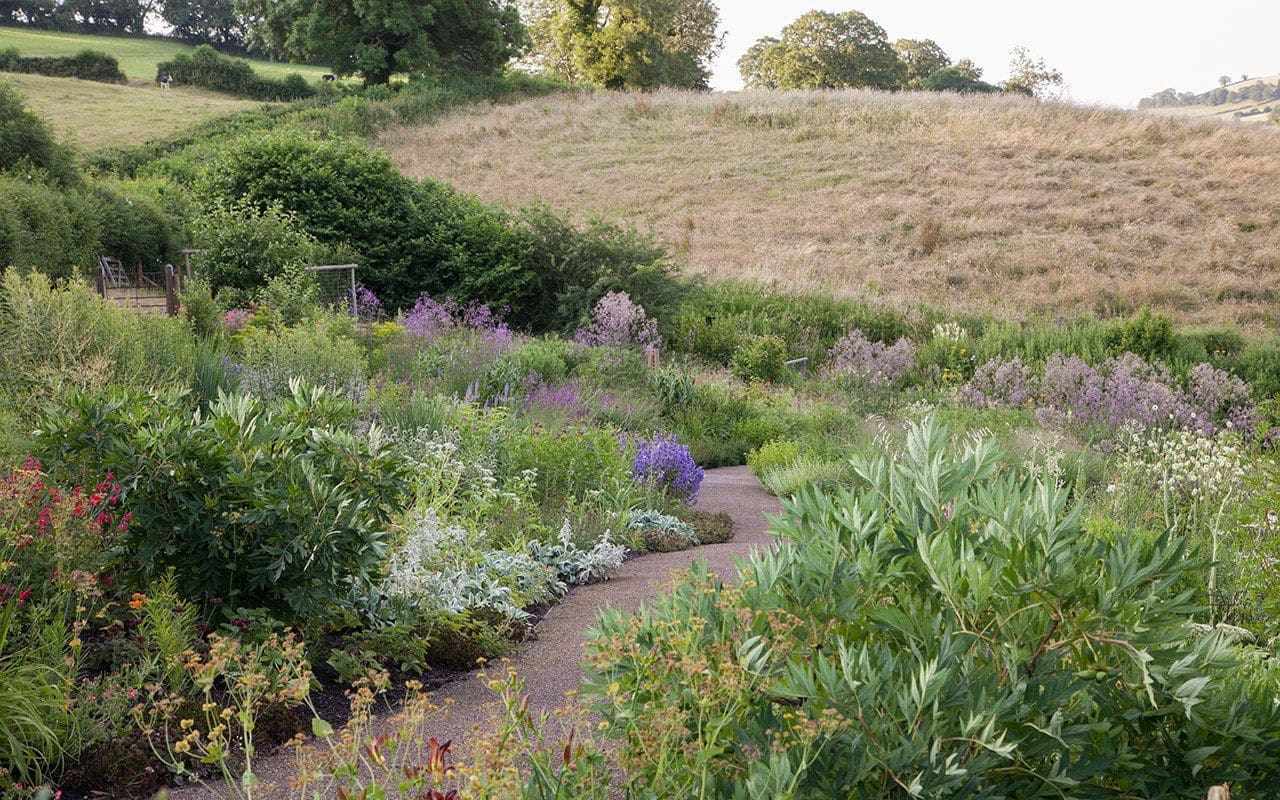 Looking down the central path from the saddle
Looking down the central path from the saddle
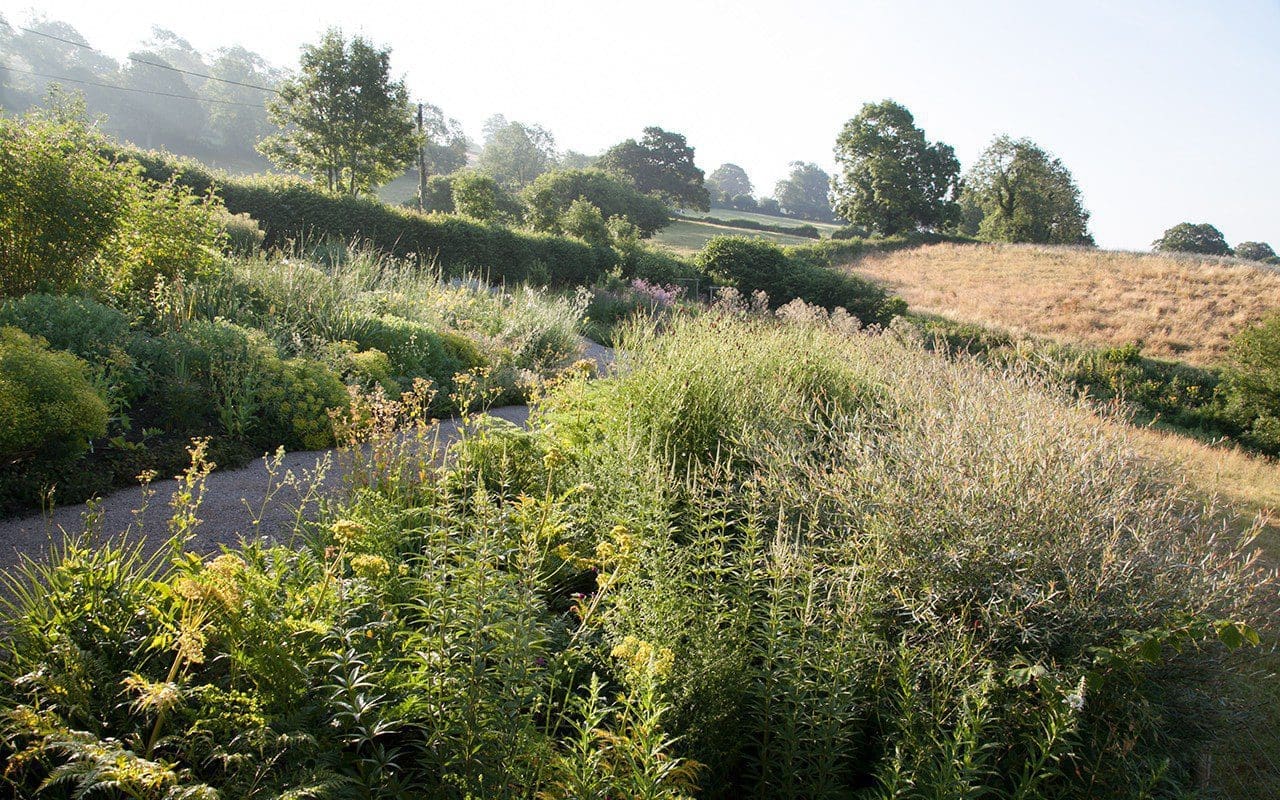 The view from the barn verandah
The view from the barn verandah
Of course, a garden is never complete. One of the joys of making and tending one is in the process of working towards a vision, but today, and despite the fact that I am already planning adjustments, I am very happy with where we are. The paths lead through growth to both sides where last year one side gave way to naked ground, and the planting spans the entire canvas provided by the beds. You can feel the volume and the shift in the daily change all around you. It has suddenly become an immersive experience.
An architect I am collaborating with came to see the garden recently and asked immediately, and in analytical fashion, if there was a system to the apparent informality. It was good to have to explain myself and, in doing so without the headset of my detailed, daily inspection, I could express the thinking quite clearly. Working from the outside in was the appropriate place to start, as the past six years has all been about understanding how we sit in the surrounding landscape. So the outer orbit of the cultivated garden has links to the beyond. The Salix purpurea ‘Nancy Saunders’ on the perimeter skip and jump to join the froth of meadowsweet that has foamed this last fortnight along the descent of the ditch. They form a frayed edge to the garden, rather than the line and division created by a hedge, so that there is flow for the eye between the two worlds. From the outside the willows screen and filter the complexity and colour of the planting on the inside. From within the garden they also connect texturally to the old crack willow, our largest tree, on the far side of the ditch.
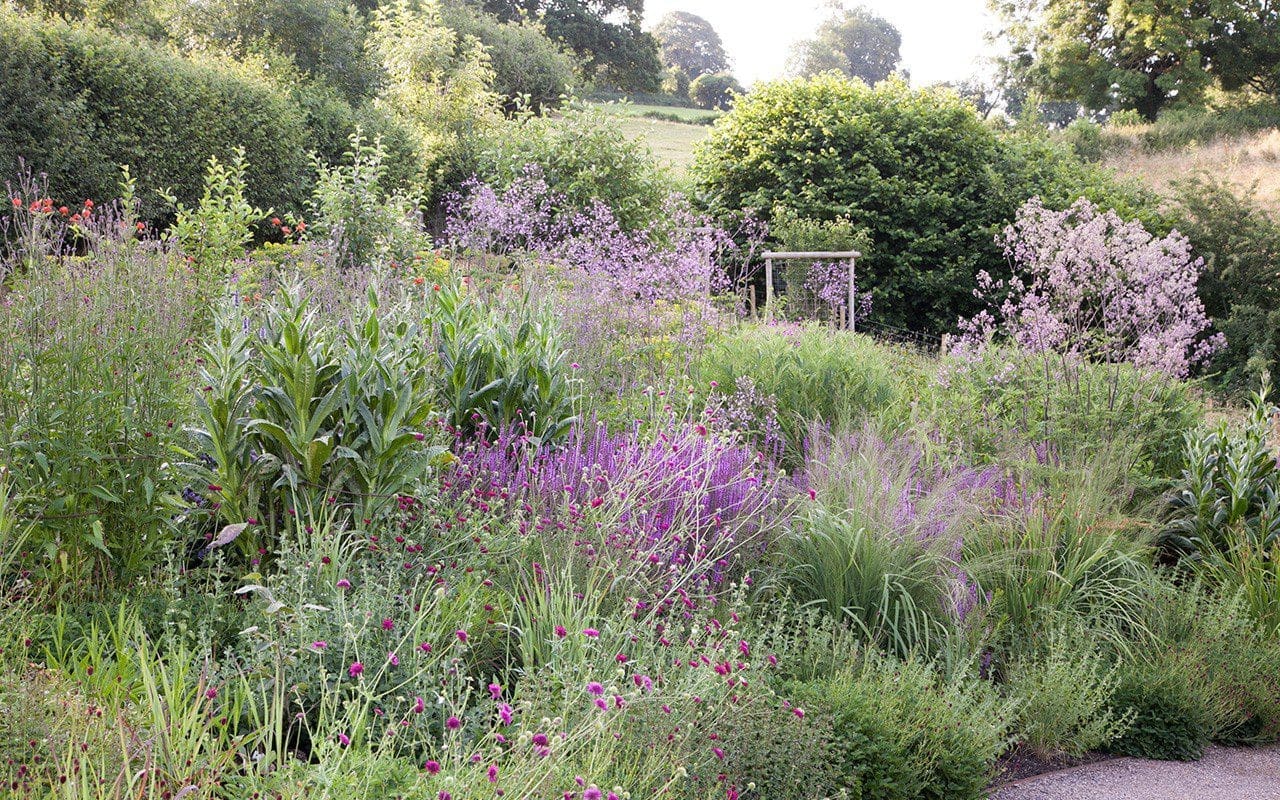 The far end of the garden which was planted in Spring 2017
The far end of the garden which was planted in Spring 2017
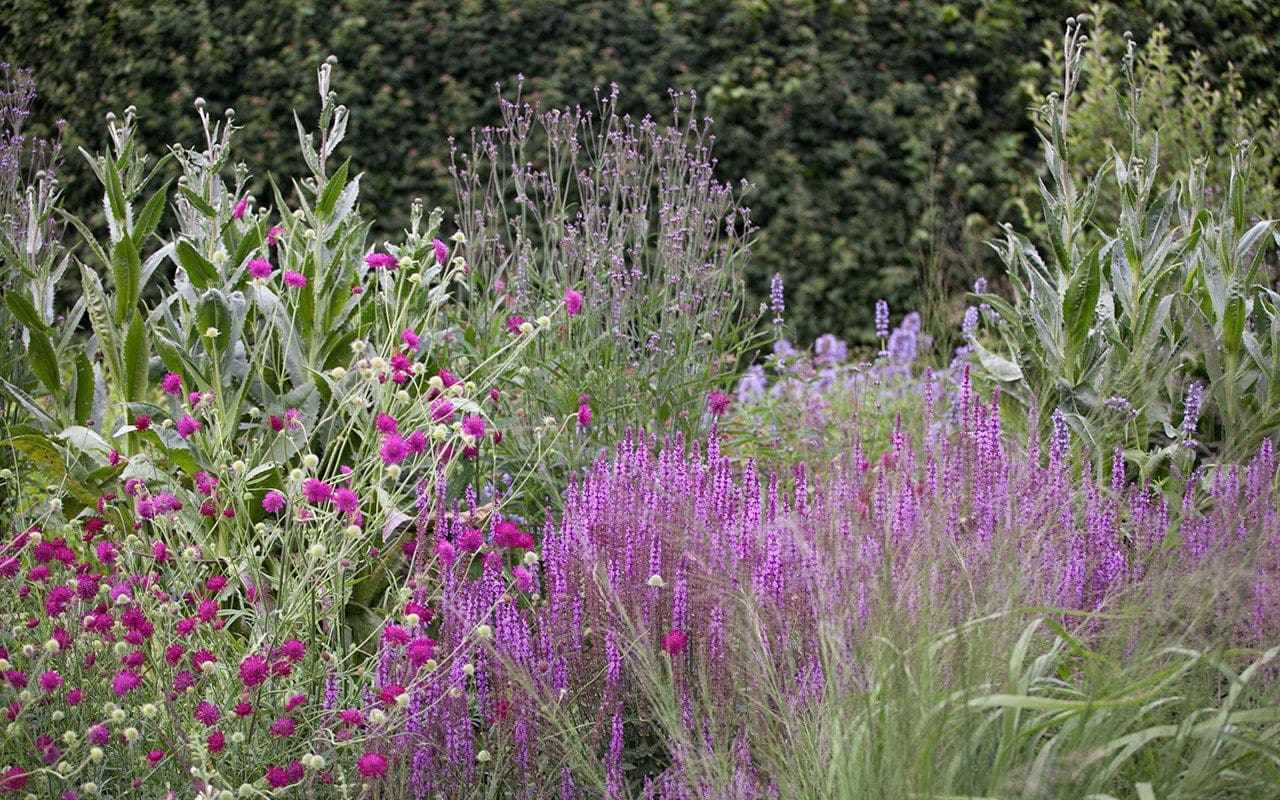 Knautia macedonica, Salvia nemerosa ‘Amethyst’, Cirsium canum and Verbena macdougallii ‘Lavender Spires’
Knautia macedonica, Salvia nemerosa ‘Amethyst’, Cirsium canum and Verbena macdougallii ‘Lavender Spires’
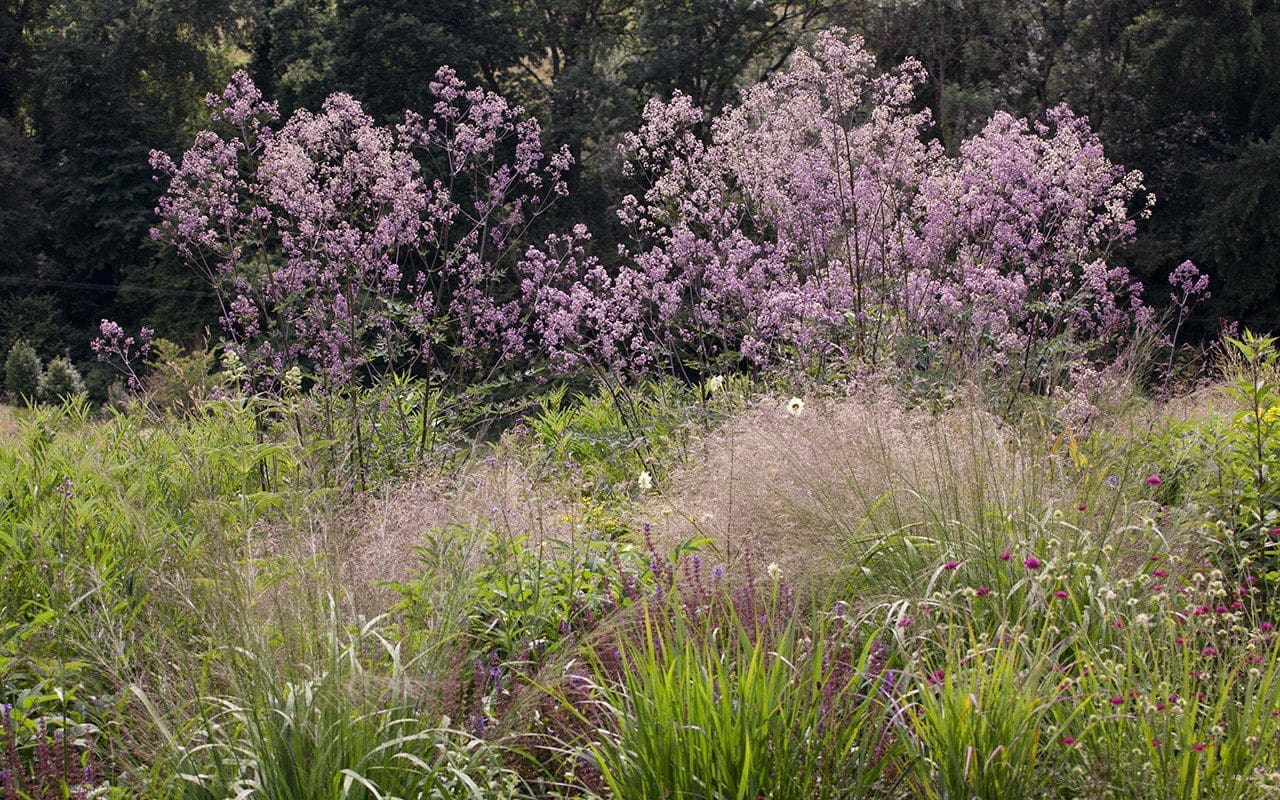 Thalictrum ‘Elin’ above Deschampsia cespitosa ‘Goldtau’
Thalictrum ‘Elin’ above Deschampsia cespitosa ‘Goldtau’
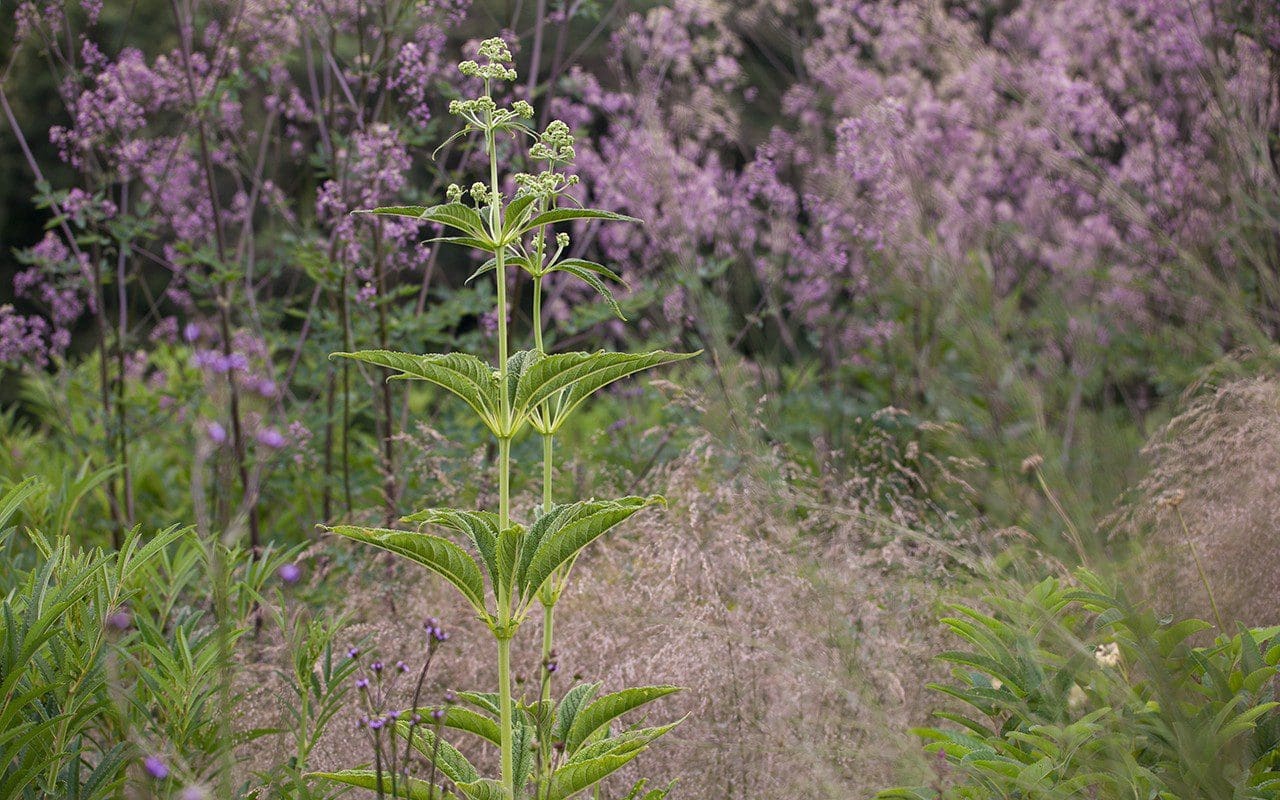 Eupatorium fistulosum f. albidum ‘Ivory Towers’ emerging through Deschampsia cespitosa ‘Goldtau’
Eupatorium fistulosum f. albidum ‘Ivory Towers’ emerging through Deschampsia cespitosa ‘Goldtau’
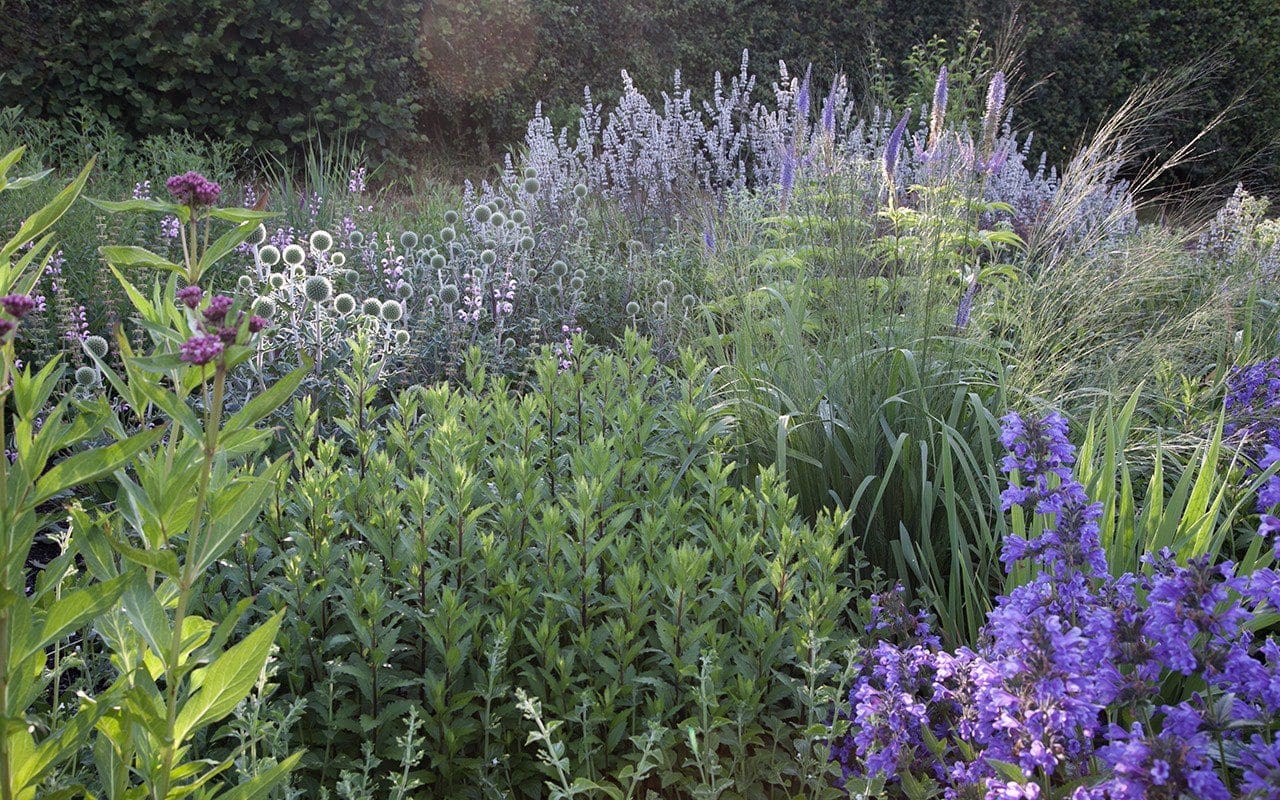 Asclepias incarnata, Echinops sphaerocephalus ‘Arctic Glow’, Nepeta nuda ‘Romany Dusk’ and Nepeta ‘Blue Dragon’
Asclepias incarnata, Echinops sphaerocephalus ‘Arctic Glow’, Nepeta nuda ‘Romany Dusk’ and Nepeta ‘Blue Dragon’
This first outer ripple of the garden is modulated. It is calm and delicate due to the undercurrent of the Deschampsia cespitosa ‘Goldtau’, but strong in its simplicity. From a distance colours are smoky mauves, deep pinks and recessive blues, although closer up it is enlivened by the shock of lime green euphorbia, and magenta Geranium psilostemon and Lythrum virgatum ‘Dropmore Purple’. Ascending plants such as thalictrum, eupatorium and, later, vernonia, rise tall through the grasses so that the drop of the land is compensated for. These key plants, the ones your eye goes to for their structure, are pulled together by a veil of sanguisorba which allows any strong colour that bolts through their gauzy thimbles to be tempered. Overall the texture of the planting is fine and semi-transparent, so as to blend with the texture of the meadows beyond.
The new planting, the inner ripple that comes closer but not quite up to the house, is the area that was planted last autumn. This is altogether more complex, with stronger, brighter colour so that your eye is held close before being allowed to drift out over the softer colour below. The plants are also more ‘ornamental’ – the outer ripple being their buffer and the house close-by their sanctuary. A little grove of Paeonia delavayi forms an informal gateway as you drop from the saddle onto the central path while, further down the slope a Heptacodium miconioides will eventually form an arch over the steps down to the verandah, where the old hollies stand close by the barn. In time I am hoping this area will benefit from the shade and will one day allow me to plant the things I miss here that like the cool. The black mulberry, planted in the upper stockbeds when we first arrived here, has retained its original position, and is now casting shade of its own. Enough for a pool of early pulmonaria and Tellima grandiflora ‘Purpurteppich’, the best and far better than the ‘Purpurea’ selection. It too has deep, coppery leaves, but the darkness runs up the stems to set off the lime-green bells.
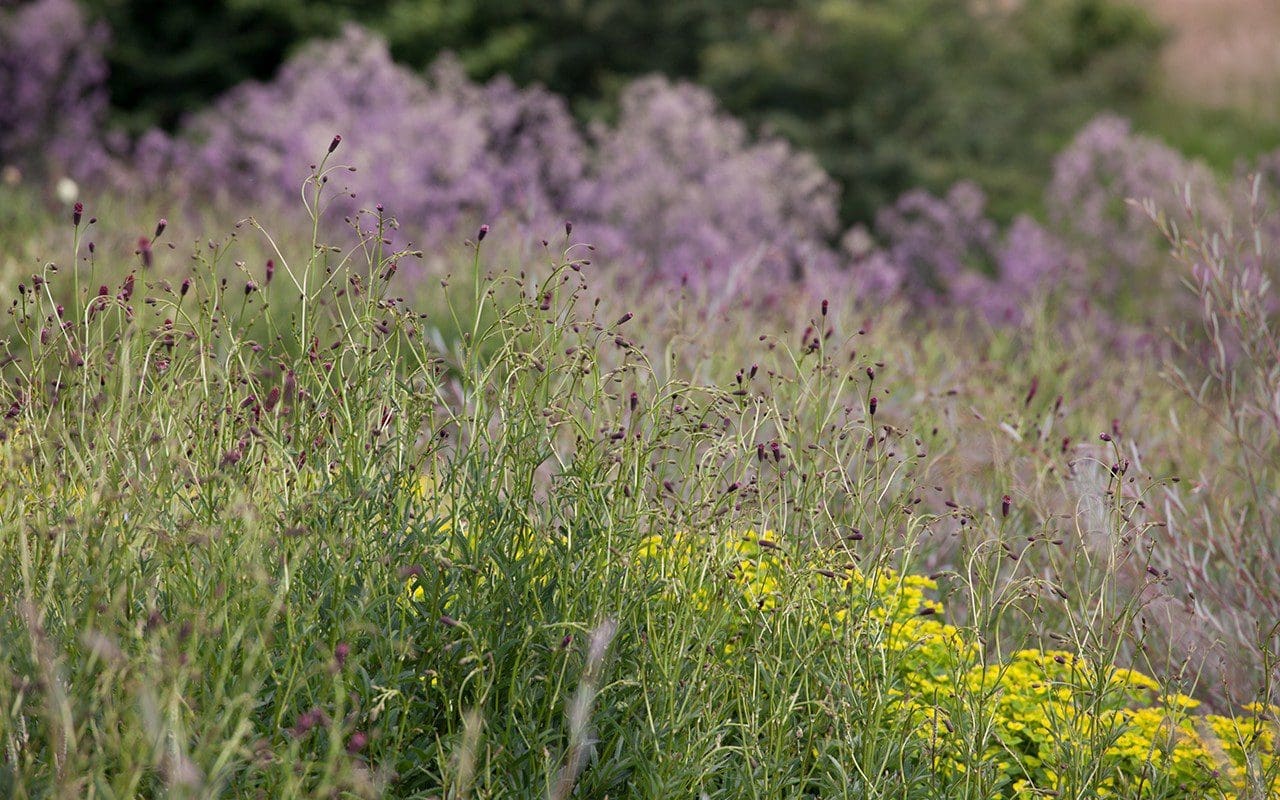 Sanguisorba officinalis ‘Red Thunder’, Euphorbia wallichii and Thalictrum ‘Elin’
Sanguisorba officinalis ‘Red Thunder’, Euphorbia wallichii and Thalictrum ‘Elin’
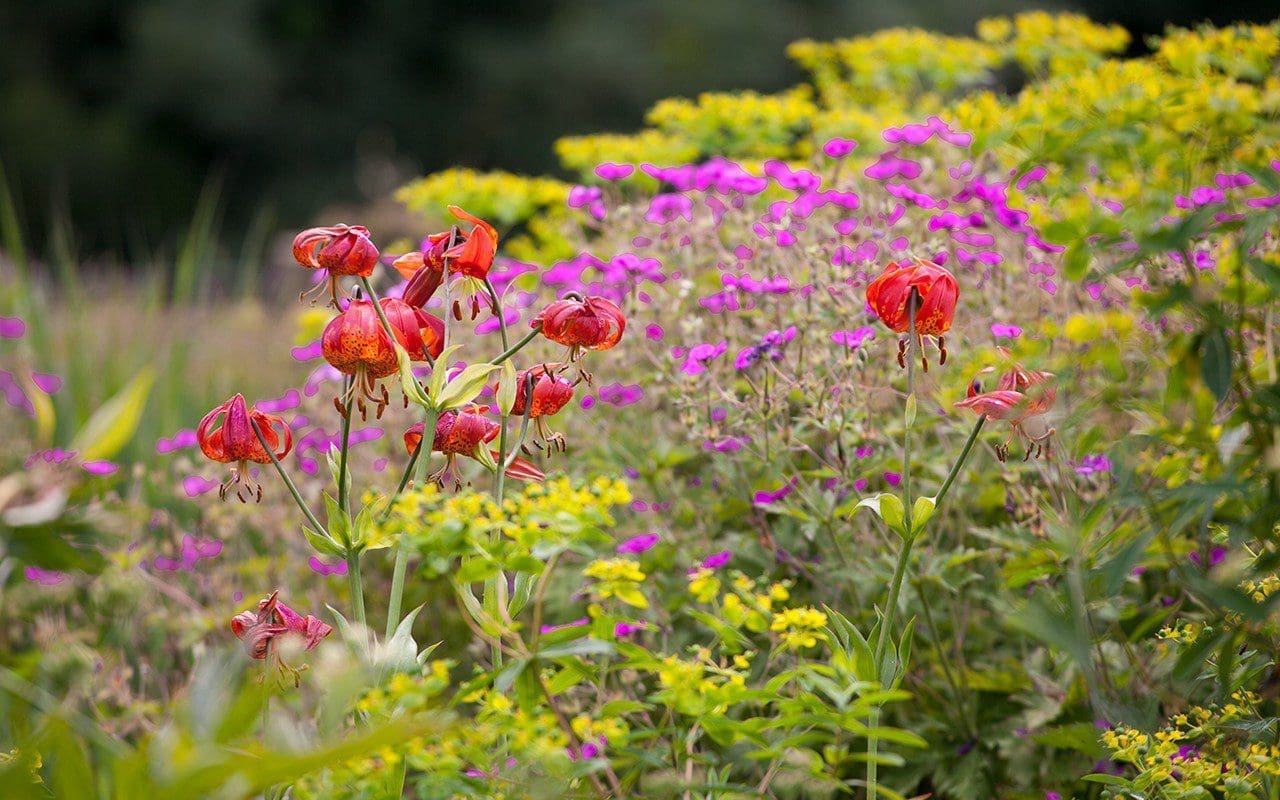 Lilium pardalinum, Geranium psilostemon and Euphorbia cornigera
Lilium pardalinum, Geranium psilostemon and Euphorbia cornigera
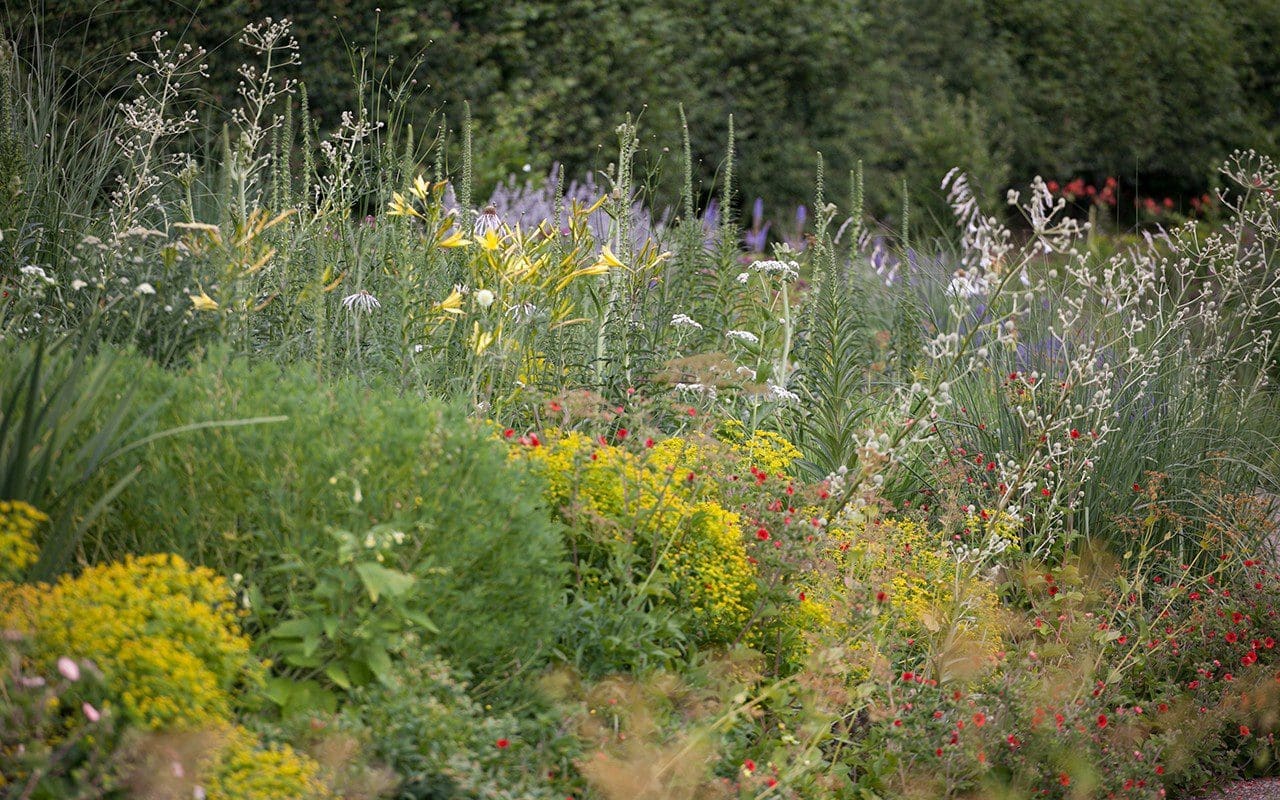 The newly planted central area
The newly planted central area
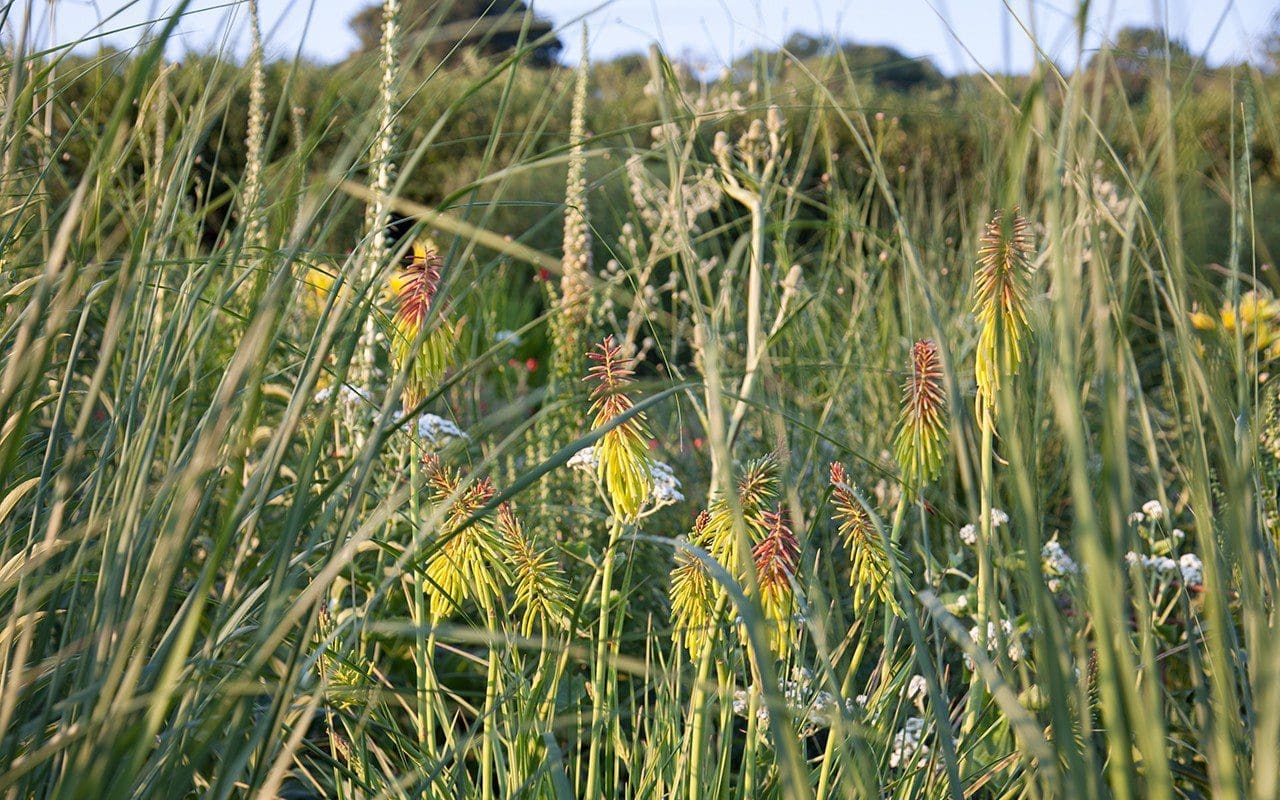 Kniphofia rufa, Eryngium agavifolium and Digitalis ferruginea
Kniphofia rufa, Eryngium agavifolium and Digitalis ferruginea
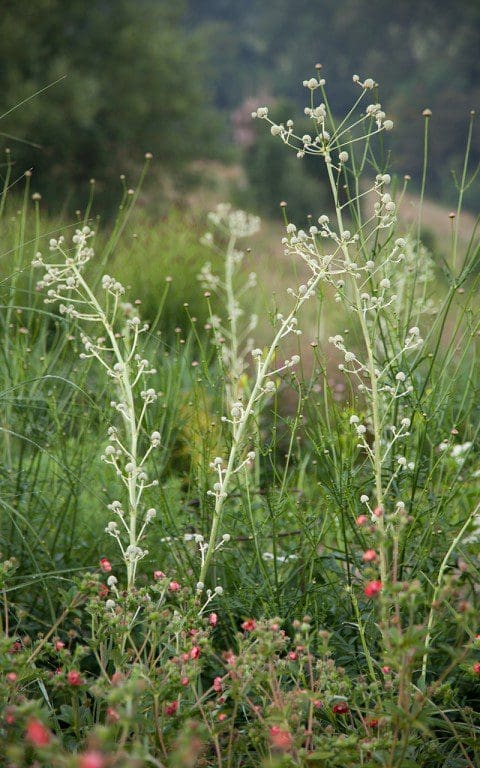 Eryngium eburneum
Eryngium eburneum
There is little shade anywhere else and the higher up the site you go the drier it gets as the soil gets thinner. This is reflected in a palette of silvers and reds with plants that are adapted to the drier conditions. I am having to make shade here with tall perennials such as Aster umbellatus so that the Persicaria amplexicaulis ‘Blackfield’, which run through the upper bed, do not scorch. Where the soil gets deeper again at the intersection of paths, a stand of Panicum virgatum ’Cloud Nine’ screens this strong colour so it can segue into the violets, purples and blues in the beds below. I have picked up the reds much further down into the garden with fiery Lilium pardalinum. They didn’t flower last year and have not grown as tall as they did in the shelter of our Peckham garden, but standing at shoulder height, they still pack the punch I need.
The central bed, and my favourite at the moment, is detailed more intensely, with finer-leaved plants and elegant spearing forms that rise up vertically so that your eye moves between them easily. Again a lime green undercurrent of Euphorbia ceratocarpa provides a pillowing link throughout and a constant from which the verticals emerge as individuals. Flowering perennials are predominantly white, yellow and brown, with a link made to the hot colours of the upper bed with an undercurrent of pulsating red Potentilla ‘Gibson’s Scarlet’. Though just in their first summer, the Eryngium agavifolium and Eryngium eburneum are already providing the architecture, while the tan spires of Digitalis ferruginea, although short-lived, are reliable in their uprightness.
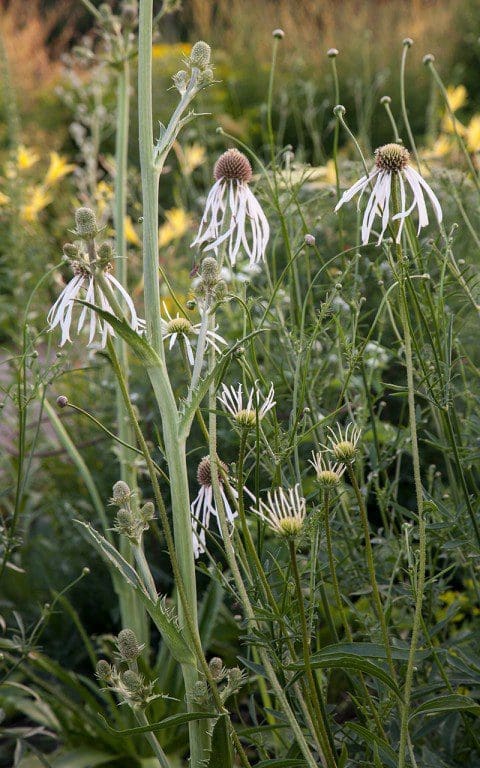 Echinacea pallida ‘Hula Dancer’ and Eryngium agavifolium
Echinacea pallida ‘Hula Dancer’ and Eryngium agavifolium
 Scabiosa ochroleuca
Scabiosa ochroleuca
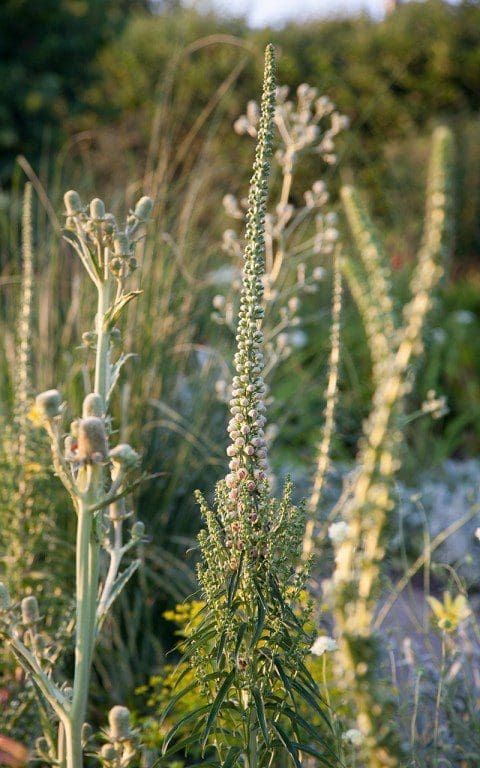 Digitalis ferruginea, Eryngium agavifolium and E. eburneum
Digitalis ferruginea, Eryngium agavifolium and E. eburneum
 Hemerocallis ochroleuca var. citrina, Digitalis ferruginea, Achillea ‘Mondpagode’ and Scabiosa ochroleuca
Hemerocallis ochroleuca var. citrina, Digitalis ferruginea, Achillea ‘Mondpagode’ and Scabiosa ochroleuca
It has been good to have had the pause between planting up the outer beds in spring last year, before planting the central and upper areas in the autumn. We are now seeing the whole garden for the first time as well as the softness and bulk of last year’s planting against the refinement and intensity of the new inner section. Constant looking and responding to how things are doing here is helping this new area to sit, and for it to express its rhythms and moments of surprise.
I am taking note with a critical eye. Will Achillea ‘Mondpagode’ have a stay of execution now that it is protected in the middle of the bed ? Last year, planted by the path, it toppled and split in the slightest wind. Where are the Rudbeckia subtomentosa ‘Henry Eilers’ and, if they have failed, how will I get them in again next year when everything will be so much bigger ? Have I put too many plants together that come too early ? Too much Cenolophium denudatum, perhaps ? How can this be remedied ? Later flowering asters and perhaps grasses where I need some later gauziness. Will the Dahlia coccinea var. palmeri grow strongly enough to provide a highlight above the cenolophium and, if not, where should I put them instead ? The season will soon tell me. The looking and the questioning keep things moving and ensure that the garden will never be complete.
Words: Dan Pearson / Photographs: Huw Morgan
Published 7 July 2018
Last Monday we awoke to a pristine frost, the first of the year. It lay heavy, sweeping up to tickle the grassy banks, but sparing the giant dahlia in the shelter of the barn. For now. I was up early, the moon still in the sky, to check on the pelargoniums which I’d moved in under cover of the open barn the night before. It was the beginning of the season’s change. From now on the garden will drop back and recede into winter.
In the seven years we have been here this shift has happened almost exactly to the week, but with every year there has been increasingly more to draw from in the garden. Despite the freeze that saw tender nasturtiums wilted and the dahlias in the open blackened, we are far from done in terms of interest. The grasses have come into their own as the colour of flower fades elsewhere. Panicum virgatum ‘Rehbraun’ is of particular note, but it has taken this long to reach its current perfection. The last few weeks have seen this late season grass at its best, the smoky panicles forming a mist amongst the perennials. As the weather has cooled, the foliage has now coloured too, a deep mahogany red.
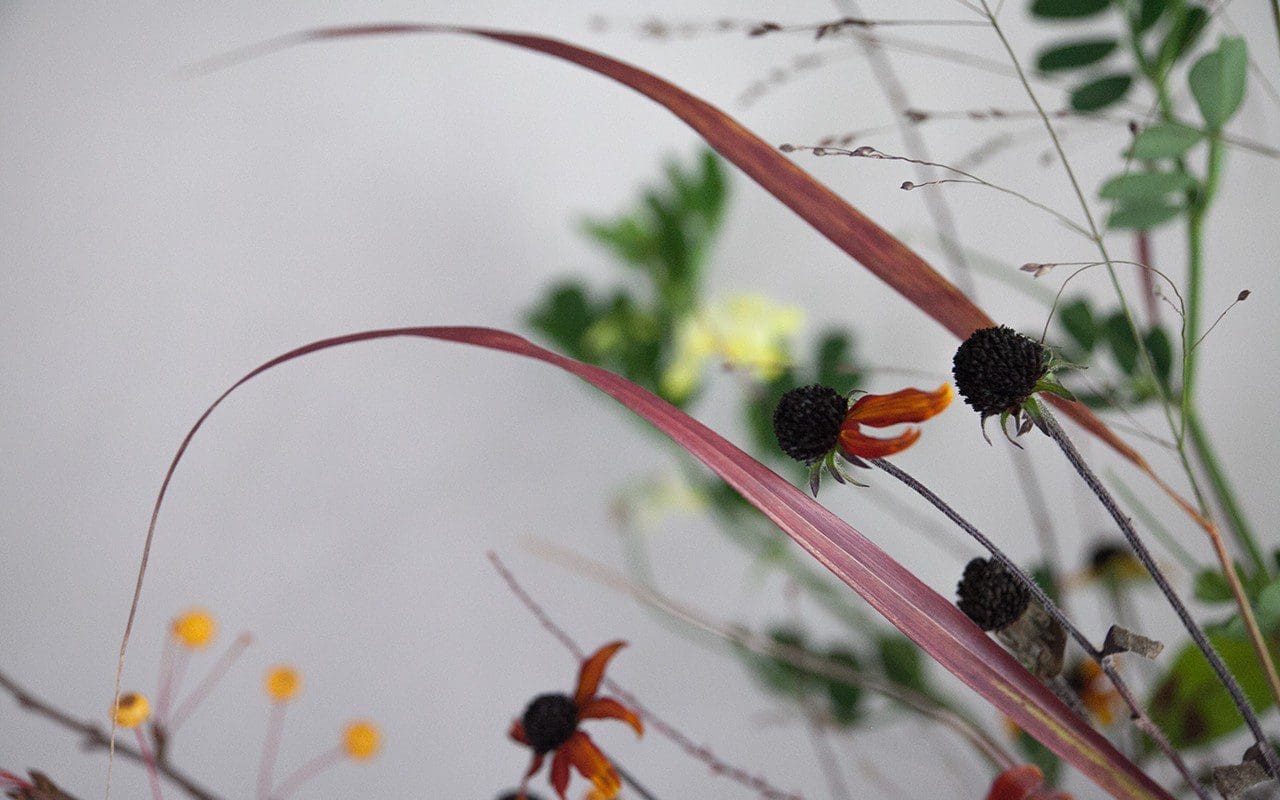 Foliage of Panicum virgatum ‘Rehbraun’
Foliage of Panicum virgatum ‘Rehbraun’
Picked in a bunch the flowers of the panicum act much as they do in the planting to veil their companions and create graphic sweeps with their flamed foliage. Almost anything works in this moody suspension of colour and here we have it with the very last of the Rudbeckia ‘Prairie Glow’. This short-lived perennial is easily raised from seed. Indeed, the plants that I have in the picking beds are variable for exactly this reason. A mix of embers and charcoal, black over red or orange, with some more fiery than others. Desite the strength of colour the impression is light for the flowers are small and held freely with room between each other. In my experience the freer draining the ground in the winter, the more likely you are to keep it. A pinch of seed, taken now and sown early under cover, will ensure that you have it next year.
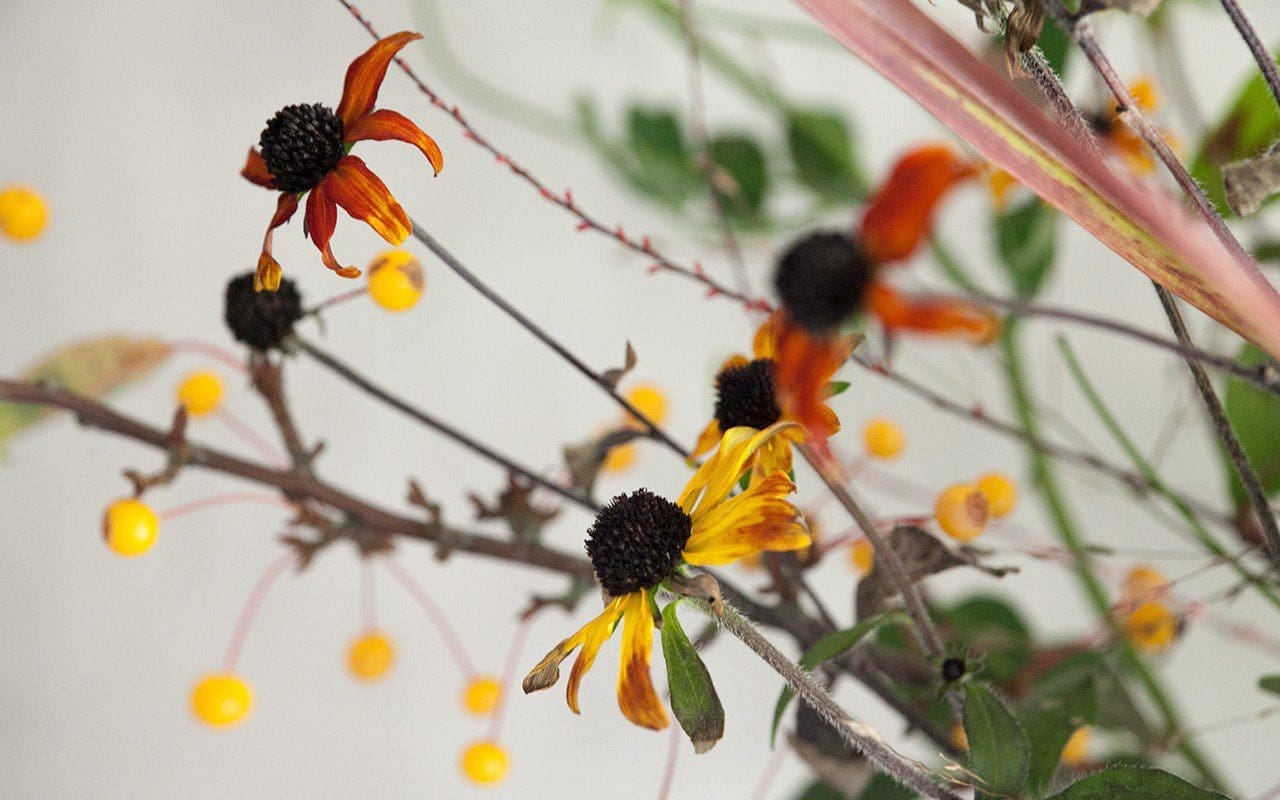 Rudbeckia ‘Prairie Glow’
Rudbeckia ‘Prairie Glow’
The Coronilla valentina subsp. glauca ‘Citrina’ has a second season of flower once the weather starts cooling, its honeyed perfume noticeable quite some distance away. I have it planted by the path so that it is easy to inhale a big lungful. This modest, woody perennial is usually at its best in early spring, flowering prodigiously in March and April and then on into early summer after a warm winter. I put this second push down to youthful exuberance and do not expect the plants to keep this up for more than three years. In the third summer I will take cuttings and replace them in new positions for they are sure to exhaust themselves. Their presence is always light and delightful, the pale yellow pea flowers darker on the lip than the keel. If you can find them a sunny free-draining position, they are easy.
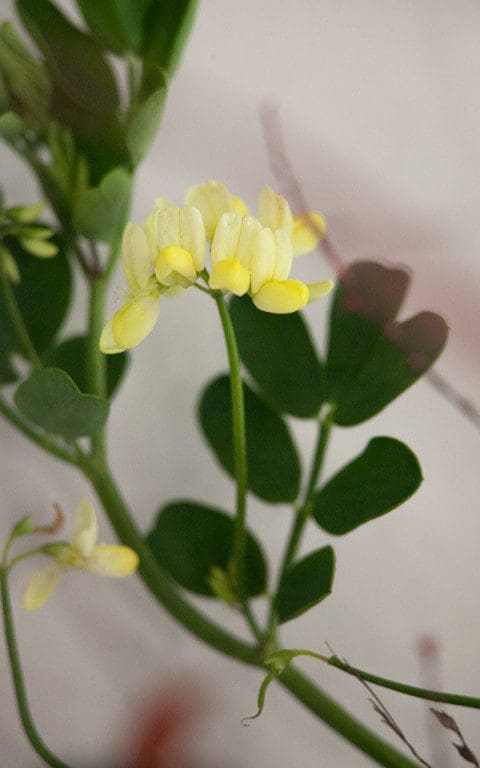 Coronilla valentina subsp. glauca ‘Citrina’
Coronilla valentina subsp. glauca ‘Citrina’
Persicaria virginiana var. filiformis is one of my favourite late season perennials. I grew them first in the Peckham garden, where they seeded freely into the shale I used for the paths. Their presence is light early in the year and, like the panicums, they take some time to come into their own in the latter half of the growing season. Grow them in a little shade or on the cool side of a building for the emerald green in the leaf to set off the maroon chevron of warpaint to best advantage. Out in the sun, the green pales and can look insipid and, as the greater part of the joy in this plant is the foliage, it is worth finding it just the right place. That said, the spires of tiny flowers are worth the wait, forming a pink haze that is hard to pin down at first, but bright and easily detectable once you find the miniature flowers scaling their wiry spires.
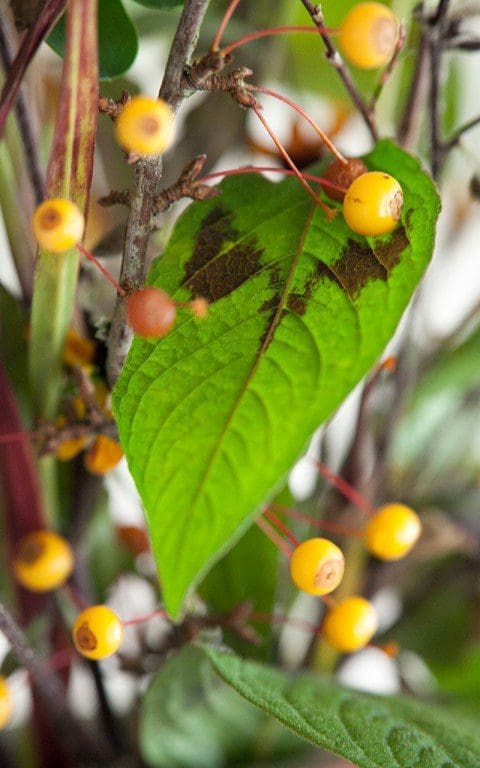 Foliage of Persicaria virginiana var. filiformis
Foliage of Persicaria virginiana var. filiformis
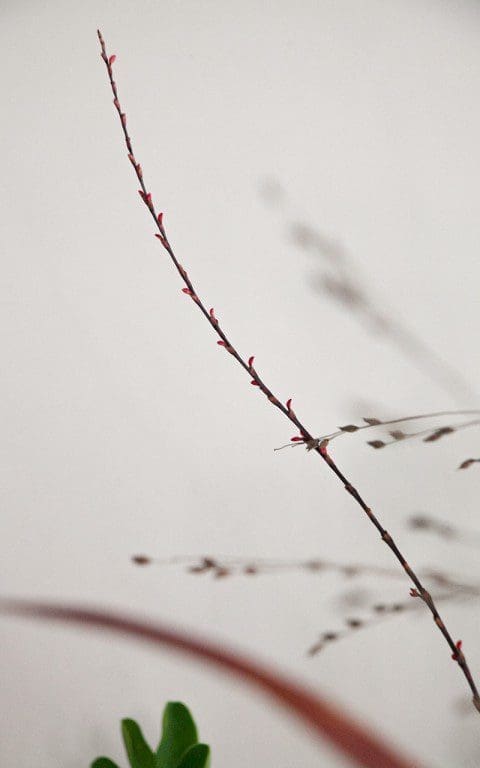 Flower spike of Persicaria virginiana var. filiformis
Flower spike of Persicaria virginiana var. filiformis
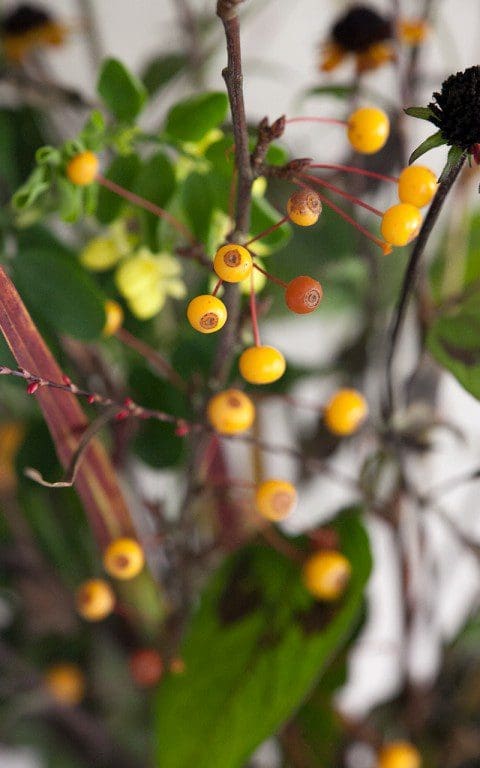 Berries of Malus transitoria
Berries of Malus transitoria
Our Malus transitoria coloured a bright, buttery yellow this year, before the leaves were stripped by gales to leave the berries hanging delicately in their thousands. The tiny amber beads, which darken to a reddish tan as they ripen, are perfectly bite-sized for the birds and every morning they are full of fluttering life. At this teetering point between the seasons this is a moment worth eking out and savouring. A last flash of life before winter gets its grip and competition for the berries will see them vanish with the last of the flowers.
Words: Dan Pearson / Photos: Huw Morgan
Published 11 November 2017
The last week has seen a subtle shift, with a hint of the next season in the air. With cool nights and mist lolling in the hollows, the garden is between two seasons. The brilliant lythrum spires have finally run out of bud and, like sparklers fizzing their length, are suddenly extinguished. The dry days have been spun with the flock from the white rosebay willow herb caught on the breeze. I have planted it on the edges of the garden to blur the boundaries and, after weeks of flower, it is finally running to seed. I know it will need managing as it is a prodigious runner, but thank goodness it is not like our pink native Chamaenerion angustifolium, for the the seed is sterile.
This week’s bunch is a push against this mood, which can all too easily descend as summer runs out of steam and autumn is yet to take over. Over the years I’ve learned to plan for the between seasons lull and now no longer fear it. The Angelica sylvestris is a perfect example of a plant that steps in to fill the gap. In the ditch where we have cleared the damp ground of bramble they are now seeding freely. Although this wetland native has been wonderful since the spring, with it’s coppery foliage and architectural loftiness, the month of August is really its moment. It has been all but invisible for a while, with the grasses staking their position earlier on, but now the pristine umbels are held amongst their spent, tawny seedheads.
 Angelica sylvestris
Angelica sylvestris
Some years, when we walk the ditch early in the season, you can spot a particularly fine form with dark, plum-coloured foliage. The dark stems are always a lovely feature of the Angelica but, coupled with dark leaves, they can not be bettered. Each year I mean to save seed of the best forms, but have never remembered to mark the plants before they are over and browned to skeletons. This autumn I plan to bring a selection called ‘Vicar’s Mead’ into the damper, lower slopes of the new garden. I have grown it without success in London, where it was too dry for it and mildew took its toll, but I trust the ground to be hearty enough here. Though biennial Angelica sylvestris will seed freely and, as long as you leave a number of seedlings, you will always get a succession.
In the garden, I have a particularly lovely form of the perennial Angelica edulis, which is planted through the white Persicaria amplexicaule. The substance and loftiness of the umbels with their horizontal conclusion is a good compliment to the finely drawn verticals, which echo the now spent grasses that surround the angelicas in the ditch. Persicaria is a mainstay of my plantings, which I have depended on for years. Happy with the cool of company at the root and with its head out in the sun, its lush foliage is an excellent team player. Good for the first half of the summer with its overlapping shield-shaped leaves, you know the season is progressing when the first spires arrive at the end of July. Again, August is their month, but they will sail through September and still be firing away in October with the asters. Here, for contrast with the blue, is a new favourite, Persicaria amplexicaule ‘September Spires’, which is tall enough to be making its way through the Verbena macdougalii ‘Lavender Spires’, and is an enlivening shade of hot pink.
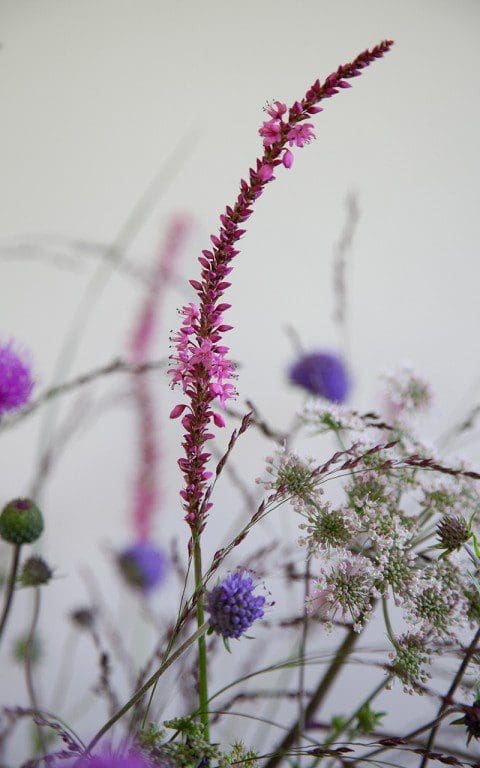 Persicaria amplexicaule ‘September Spires’
Persicaria amplexicaule ‘September Spires’
The Panicum virgatum ‘Rehbraun’ is a late-season grass. Slow to get started in the early summer and needing space early on so as not to be overwhelmed by early-into-leaf companions. An American native known as Switch Grass, it is happiest on lean ground and in bright conditions. Here it is better in soil that is drier or it will lean and topple. I have it on the upper, free-draining slopes where it is already showing colour with reddened tips to the foliage. The plum-coloured flowering panicles are so fine and delicate that you can see through their dusky framework. By the end of the month they will ascend to a final height of about a metre and will then go on to colour brilliantly in October, fiery and lit with their own inner light it seems.
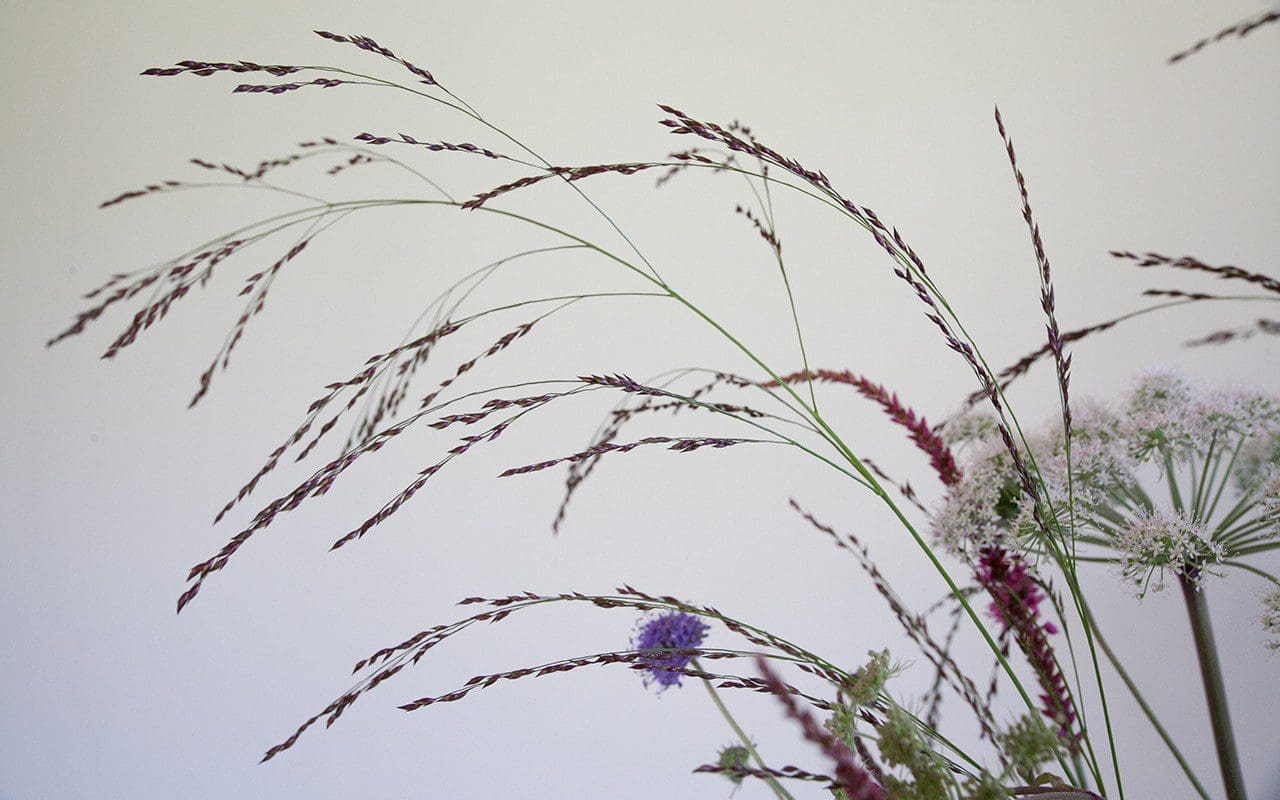 Panicum virgatum ‘Rehbraun’
Panicum virgatum ‘Rehbraun’
I have them planted close, but not too close, to the Cirsium canum, which is as lush as the grass is fine. I bought this perennial thistle from Special Plants where Derry Watkins has it growing in her garden. She swore then that it wasn’t a seeder, as I had been stung by its similar cousin, the native Cirsium tuberosum. The latter has now been banished from the garden to the ditch banks for bad behaviour in the seeding department and, for the past three years, has been kept in check by the competition. When I last saw Derry and asked her if her C. canum had started to seed she said, “a little”, which was due caution, so I will raze my plants when the main show is over to avoid the inevitable. Their stature, reach and poise are beautiful though, the brilliant pink thimbles of flower spotting colour in mid-air just above our heads and humming with bees.
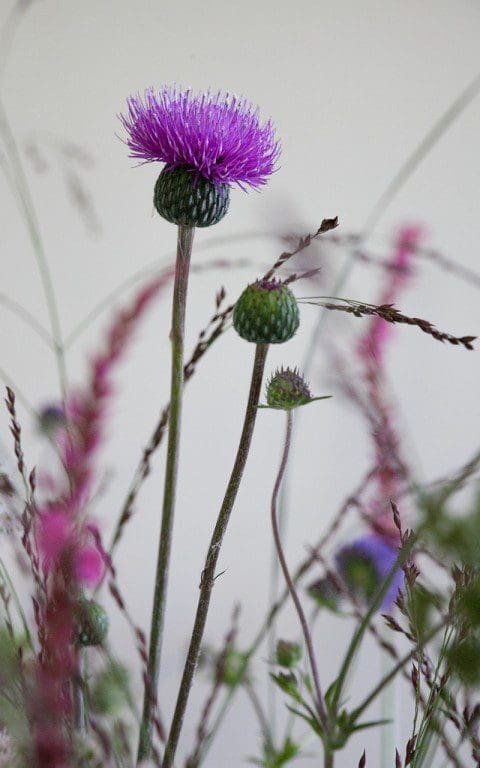 Cirsium canum
Cirsium canum
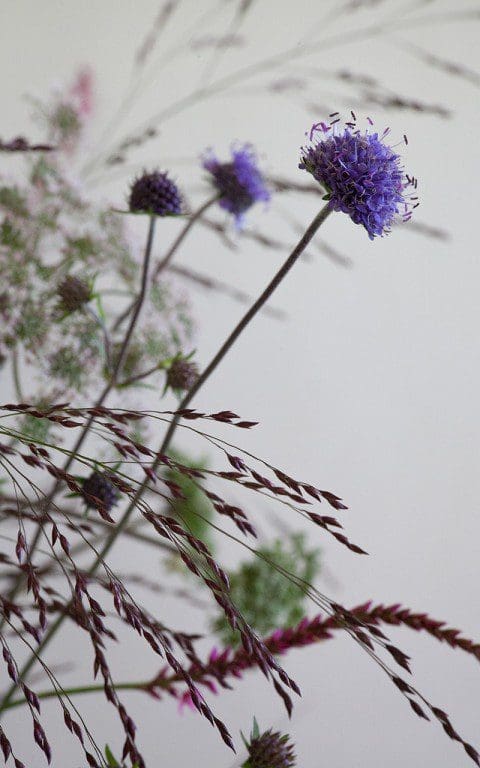 Succisa pratensis
Succisa pratensis
Though at an altogether smaller scale, the Devil’s Bit Scabious has a similar feeling in the suspension of flower on wiry stems. Another native, Succisa pratensis is a late-performing meadow dweller, happiest where the soil is moist and picking up where many other natives have gone over in August. My original plant, a dark blue selection called ‘Derby Purple’ was the parent of the seedlings in this bunch. They came easily from seed, germinating the same autumn they were sown and flowering just a year later in the new plantings. Although the flowers are darker than the native, they are not as rich as their parent, but they are a wonderful thing to have hovering around in this between season moment. A neat rosette of foliage, that will slowly increase and clump, is easily combined in well-mannered company. I will keep them away from the Cirsium and run them instead through the openly spaced Switch Grass and be happy in the knowledge that their contribution will help to bridge the season.
Words: Dan Pearson / Photographs: Huw Morgan
Published 19 August 2017
This winter’s notable run of frosts has already marked this year as distinct from the mild run we’ve had of late. We have woken again and again to a glistening world where footfall comes with a crunch and the fields and hedges are unified by the white freeze. The frost has come with clear blue skies and, as the sun has crept over the folds in the land, the colours of winter have bled back in with the thaw of its extending fingers. These are the days when I am pleased for the skeletons of the last growing season. This early into the winter most are still standing and those that will continue to do so are already showing their stamina. The bronze fennel is one of the best. It is already naturalising here, seeding around the rusty barns and even where last year’s bonfire saw them burn in the spring clear up. I have them at the front of the house with the twisted remains of the apricot evening primrose and they have been alive with birds. A flitting wren and robins rummaging around amongst their stems where the seed has fallen and great tits stripping the seed from the architecture of umbels.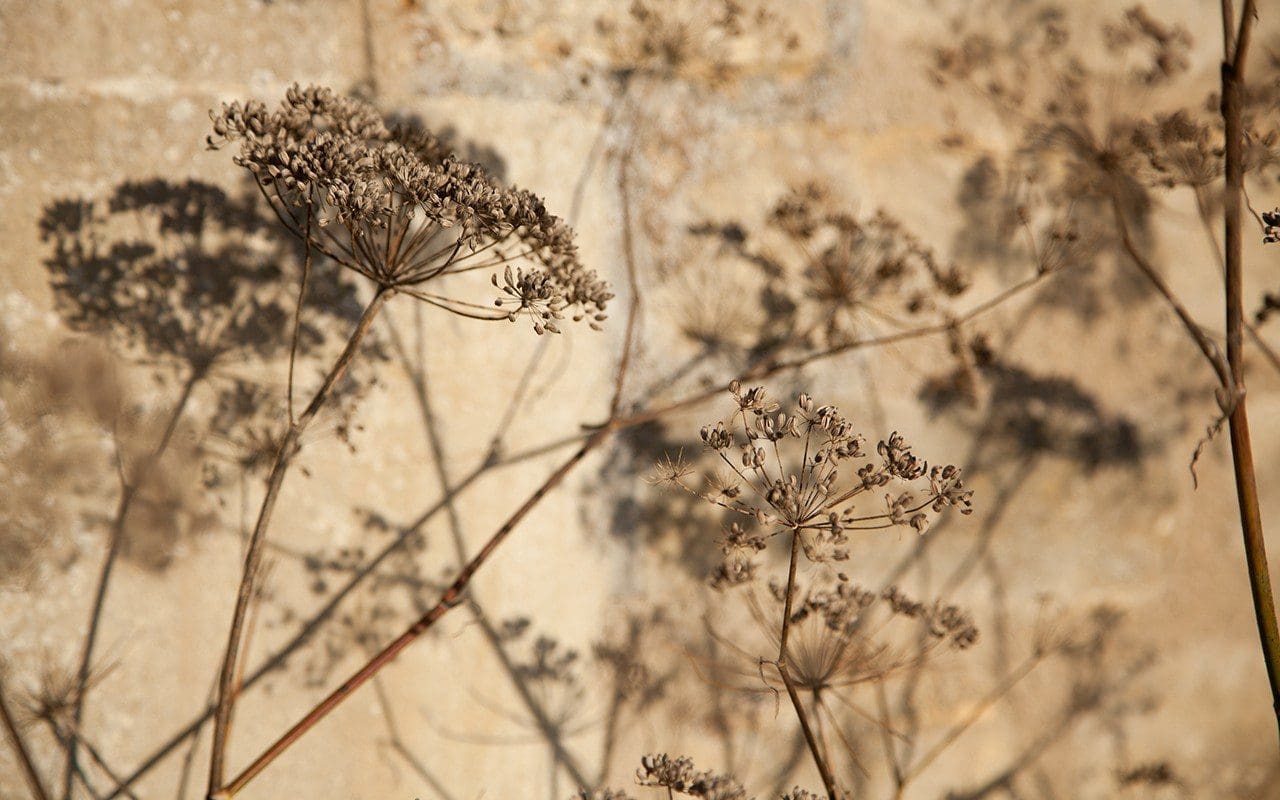 Bronze fennel
In the new garden, where I am working around the old stock beds for now, I am grateful for the reminder that I must plan for these bare bones in its winter incarnation. I want it to be a place that is as fascinating and beautiful in its death throes – and whilst resting – as it is in summer. The volunteer sunflowers left from the garden’s previous chapter, and whose seeds are stripped by the birds, are also a prompt that the garden should be as much a feeding ground as a place to study the decay and drawing back of winter. Where the ground now lies fallow, waiting and empty we will have life and light and change as the skeletons age and bleach and topple towards spring.
Bronze fennel
In the new garden, where I am working around the old stock beds for now, I am grateful for the reminder that I must plan for these bare bones in its winter incarnation. I want it to be a place that is as fascinating and beautiful in its death throes – and whilst resting – as it is in summer. The volunteer sunflowers left from the garden’s previous chapter, and whose seeds are stripped by the birds, are also a prompt that the garden should be as much a feeding ground as a place to study the decay and drawing back of winter. Where the ground now lies fallow, waiting and empty we will have life and light and change as the skeletons age and bleach and topple towards spring.
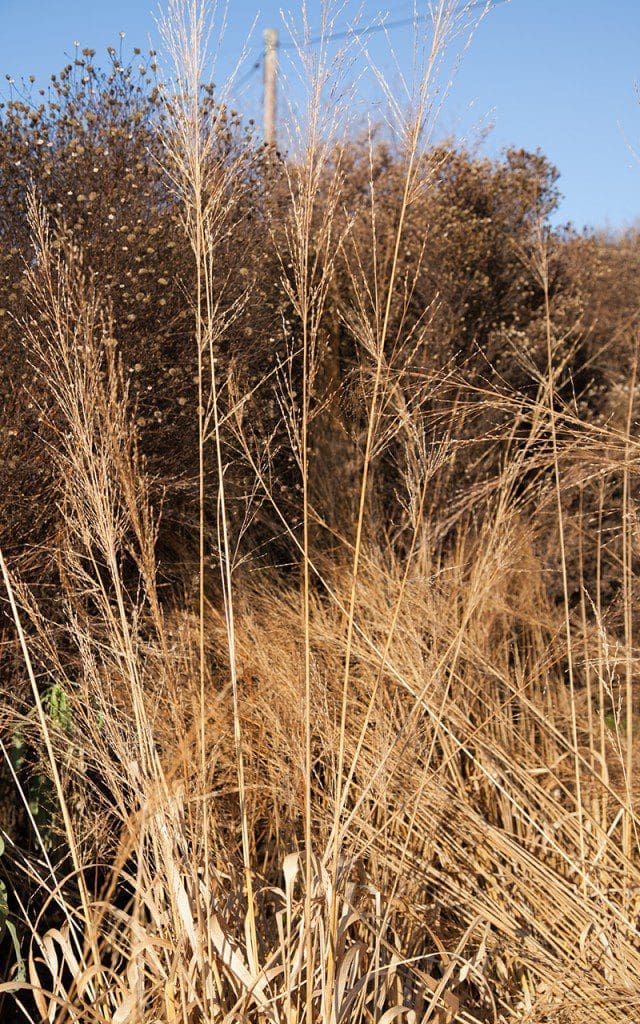 Molinia caerulea ssp. arundinacea ‘Transparent’
The Molinia caerulea ssp. arundinacea ‘Transparent’ that were standing until so very recently have already given way to the weather and lie strewn. I will remember their habit and plant them away from the path so that, when they do fall, their sheaves can be enjoyed akimbo. Their lack of endurance as skeletons can be forgiven if they are in association with plants that keep it together and stand for longer. A drift of the buff powder-puffs of Aster pyrenaeus ‘Lutetia’ or A. x herveyi with its seed now blown free to reveal their light-reflecting starry calyces. Another grass perhaps, such as the Panicums, to arrest the sun in their plumage. The aptly named P. ‘Cloud Nine’ is showing itself to be one of the best I have here, standing tall, the elegant foliage now the colour of straw and parchment, the seedheads large and open. Pale on a dry day, yellowed when it is damp.
Molinia caerulea ssp. arundinacea ‘Transparent’
The Molinia caerulea ssp. arundinacea ‘Transparent’ that were standing until so very recently have already given way to the weather and lie strewn. I will remember their habit and plant them away from the path so that, when they do fall, their sheaves can be enjoyed akimbo. Their lack of endurance as skeletons can be forgiven if they are in association with plants that keep it together and stand for longer. A drift of the buff powder-puffs of Aster pyrenaeus ‘Lutetia’ or A. x herveyi with its seed now blown free to reveal their light-reflecting starry calyces. Another grass perhaps, such as the Panicums, to arrest the sun in their plumage. The aptly named P. ‘Cloud Nine’ is showing itself to be one of the best I have here, standing tall, the elegant foliage now the colour of straw and parchment, the seedheads large and open. Pale on a dry day, yellowed when it is damp.
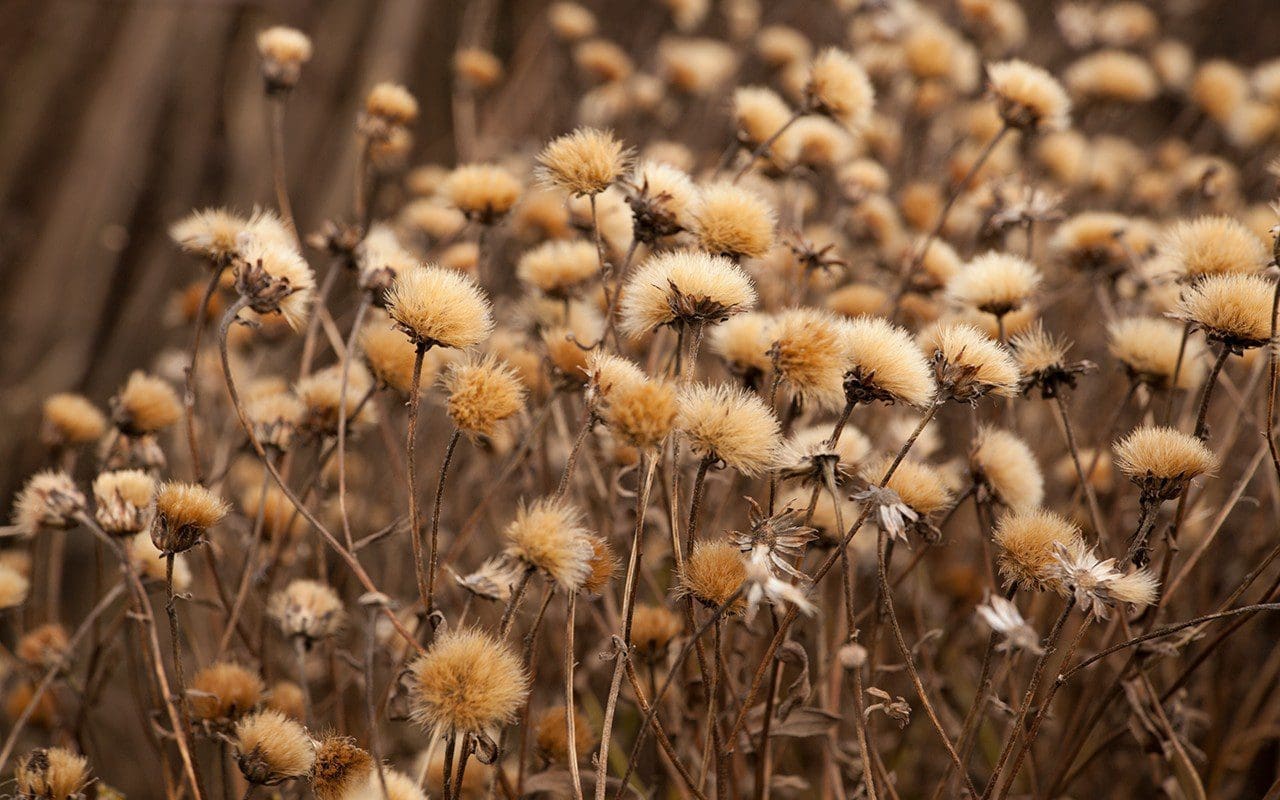 Aster pyrenaeus ‘Lutetia’
Aster pyrenaeus ‘Lutetia’
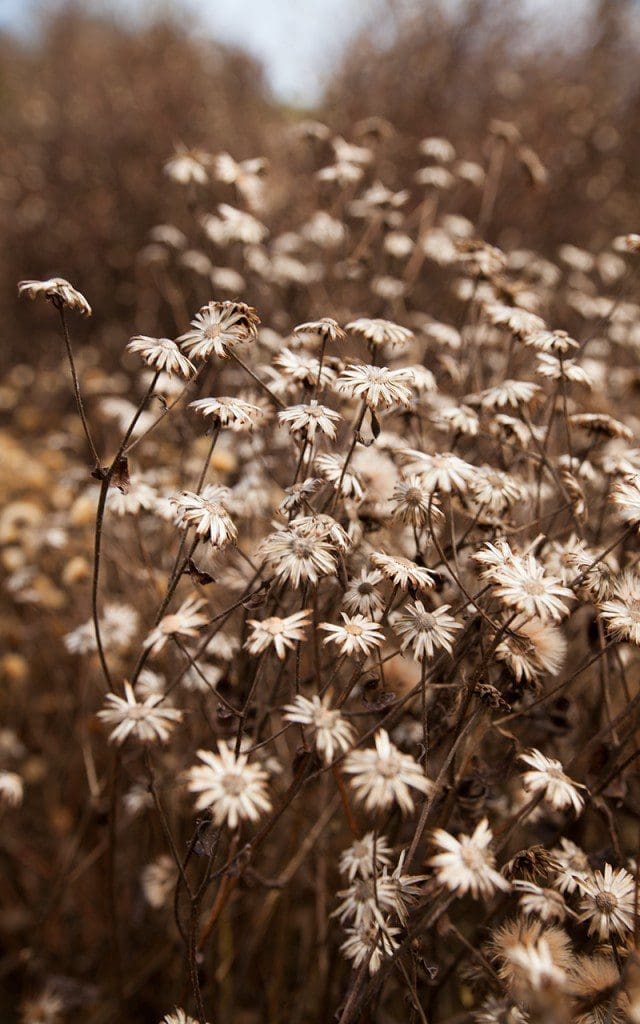 Aster x herveyi
Aster x herveyi
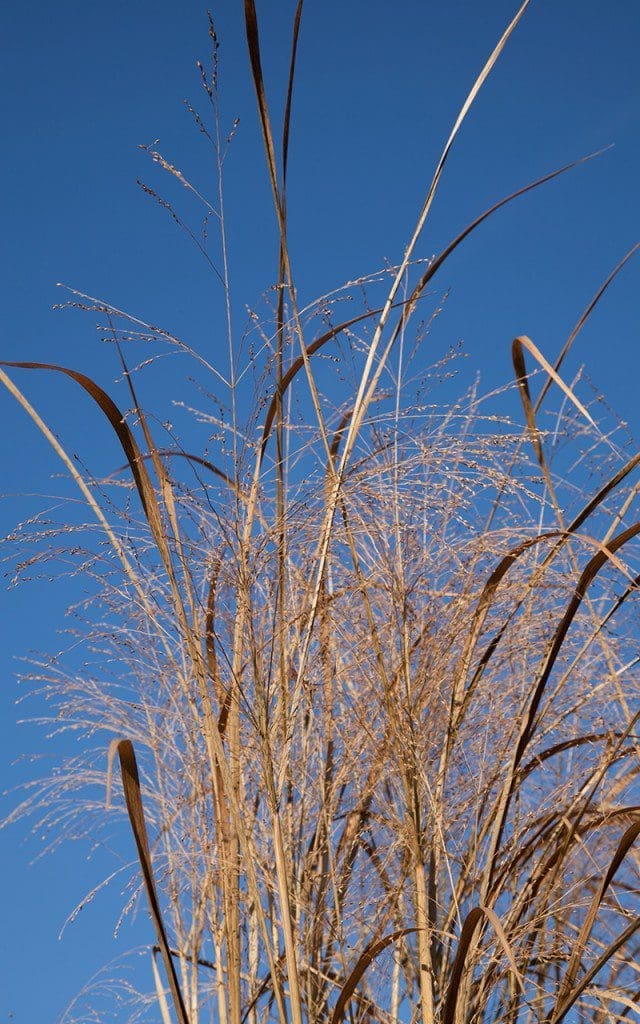 Panicum ‘Cloud Nine’
Remarkable now, and noteworthy for being at its very best in the winter, is Glycyrrhiza yunnanensis. The Yunnan liquorice is perfectly hardy here and has taken well to our sunny slopes. I first saw it on an autumn visit to Piet Oudolf’s garden with my friend and gardener from the Millennium Forest, Midori. In typical fashion Piet offered us the seed and we both took a handful of the extraordinary pods. The following spring we sowed the seed, Midori in Hokkaido and me back here back in Somerset. The plants in Japan have struggled to attain stature, despite coming through a winter beneath an eiderdown of snow, but mine have soared to well over head height and have spawned further generations which I am now nurturing in the frame for the spring planting of the new garden.
Panicum ‘Cloud Nine’
Remarkable now, and noteworthy for being at its very best in the winter, is Glycyrrhiza yunnanensis. The Yunnan liquorice is perfectly hardy here and has taken well to our sunny slopes. I first saw it on an autumn visit to Piet Oudolf’s garden with my friend and gardener from the Millennium Forest, Midori. In typical fashion Piet offered us the seed and we both took a handful of the extraordinary pods. The following spring we sowed the seed, Midori in Hokkaido and me back here back in Somerset. The plants in Japan have struggled to attain stature, despite coming through a winter beneath an eiderdown of snow, but mine have soared to well over head height and have spawned further generations which I am now nurturing in the frame for the spring planting of the new garden.
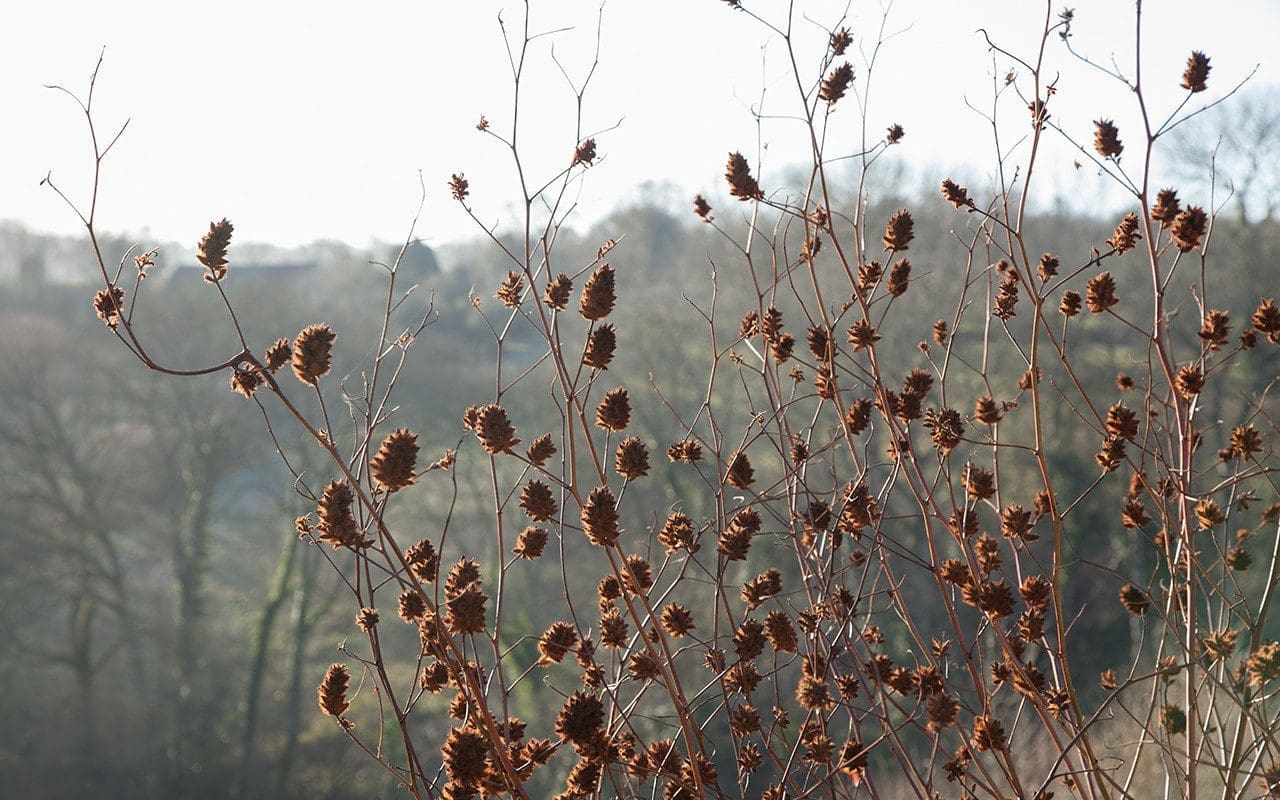 Glycyrrhiza yunnanensis
Their skeletons have been almost immune to the winter. Last year we had to fell them in the spring and cut their glory short to make way for the new growth. The cinnamon-coloured stems, which in summer are clothed with fine, pinnate foliage, stand at over two metres. The seedpods, which are the end result of a pretty but rather insignificant clutch of lilac, pea-like flowers, are as good as any seedpod gets. The size of a hens egg, and like a spiny fir cone in appearance, they are covered in rust-brown hairs that are bristly to the touch and hold the hoar frost as though it was designed for their armature. I will march them through the new garden where they can shine in the cold months and provide us with a place that will celebrate this apparent down time.
Glycyrrhiza yunnanensis
Their skeletons have been almost immune to the winter. Last year we had to fell them in the spring and cut their glory short to make way for the new growth. The cinnamon-coloured stems, which in summer are clothed with fine, pinnate foliage, stand at over two metres. The seedpods, which are the end result of a pretty but rather insignificant clutch of lilac, pea-like flowers, are as good as any seedpod gets. The size of a hens egg, and like a spiny fir cone in appearance, they are covered in rust-brown hairs that are bristly to the touch and hold the hoar frost as though it was designed for their armature. I will march them through the new garden where they can shine in the cold months and provide us with a place that will celebrate this apparent down time.
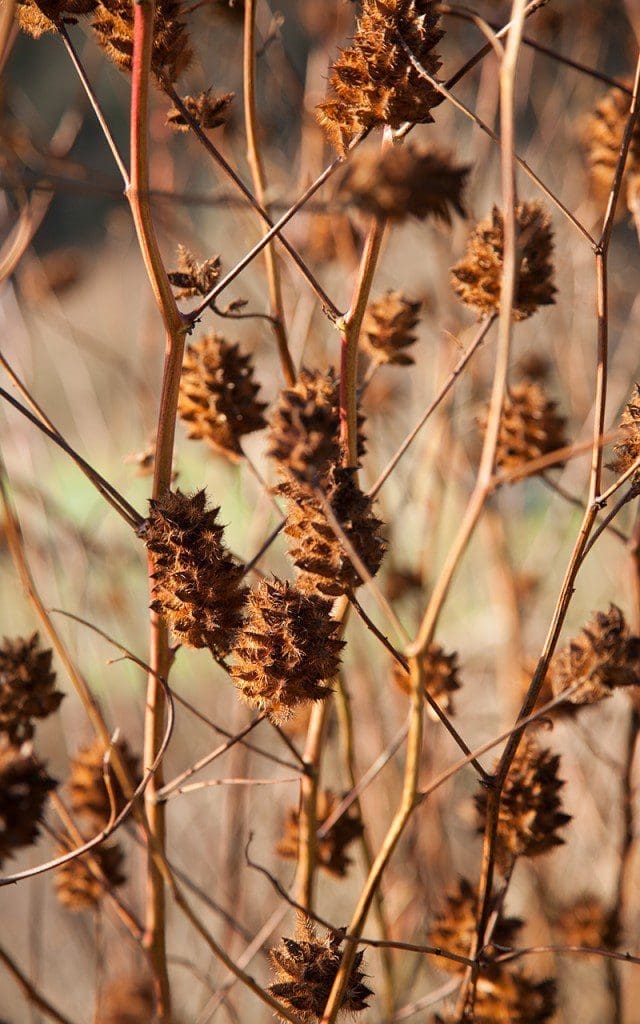 Glycyrrhiza yunnanensis seedheads
Words: Dan Pearson / Photographs: Huw Morgan We are sorry but the page you are looking
for does not exist.
You could return to the homepage
Glycyrrhiza yunnanensis seedheads
Words: Dan Pearson / Photographs: Huw Morgan We are sorry but the page you are looking
for does not exist.
You could return to the homepage